Whenever Australia is mentioned, images of wildlife, delicious big portioned meals made with fresh local produces, hopping kangaroos, and friendly laid-back Aussies always come to my mind. Indeed, Australia is a popular destination with Sydney and Melbourne taking the top two ranking as the country’s most visited cities but the immensely picturesque Northern Territory is only in the 10th position. I hope this 6 Days Road Trip to Darwin travelogue will convince readers why they should plan a visit here on their next adventure. The Northern Territory is truly spectacular and should be on everyone’s bucket list, especially nature lovers or those who don’t like mass tourism.
A Brief Insight into the Northern Territory
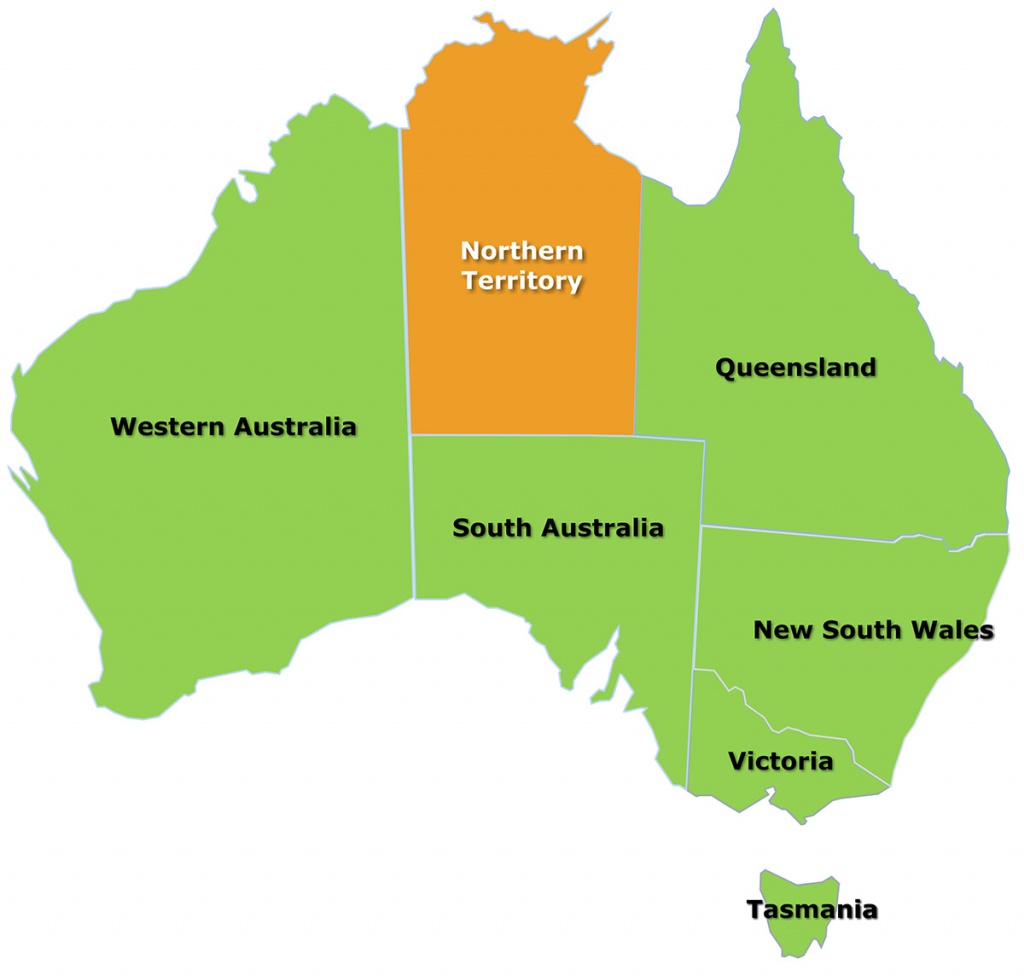
The Northern Territory (abbr- NT) is a federal territory in the central and central northern regions of Australia. Despite its huge area of over 1,349,129 sg.km, making it the third-largest Australian federal division—it is sparsely populated with a headcount of 244,000 (2016 census) rendering it the least populous of Australia’s eight major states and territories. The capital and largest city are Darwin . Today the economy is largely tourism-based, especially Kakadu National Park and the Uluru-Kata Tjuta National Park (Ayers Rock) in central Australia and mining. Residents of the NT are often known simply as “Territorians”, “Northern Territorians” or informally as “Top Enders” and “Centralians”. (Excerpts, Wikipedia)
Road Trip Routes
This 6 days road trip in mid-April to Darwin and the surrounding region was organised by Jetabout Holidays in collaboration with Tourism NT. We landed at 0510hrs in Darwin after a red-eyed 4.5 hours direct flight from Singapore. After a short rest at the Vibe Hotel Darwin Waterfront, we check out at early noon and proceeded to obtain the latest information, national park updates and maps from the Tourism Top End Visitor Information. Our 6D5N road trip saw us clocking about 1200km.
Tip #1 – Driving distance can take 2-3 hours between destinations. Break up the journey with rest stops after a 1-1.5 hours drive and observe the speed limit. Cars with 2L or larger capacity are recommended. During the wet season, a 4×4 car is highly advisable to handle areas that may have water ponding. Do rent a car with in-car GPS as network connectivity can be erratic in the vast outback.
Tip #2 – Be prepared for the environment – sunblock, sunglass, sun hat, and insect repellent are basic necessities. Arm-socks are great to have for minimising sunburn, especially during long drives.
Tip #3 – Bring along plenty of snacks and loads of humour for a more enjoyable drive. Locals drive fast on the road but are generally law-abiding. Some may even wave at you as you pass each other as a matter of road etiquette.
Day #1 – Jumping Crocodile Cruise
Our 1st activity to “jumpstart” the trip was the jumping crocodile cruise located at Adelaide River, an easy 55 mins drive from our hotel in Darwin.

A “must-do” to have a picture taken at this renowned venue signboard. Crocodile hunting has been banned since the ’70s and the population has recovered to sustainable levels. To earn a living, a crocodile hunter named Stephan started the Original Jumping Crocodile Cruise, pioneering an attraction to the area.
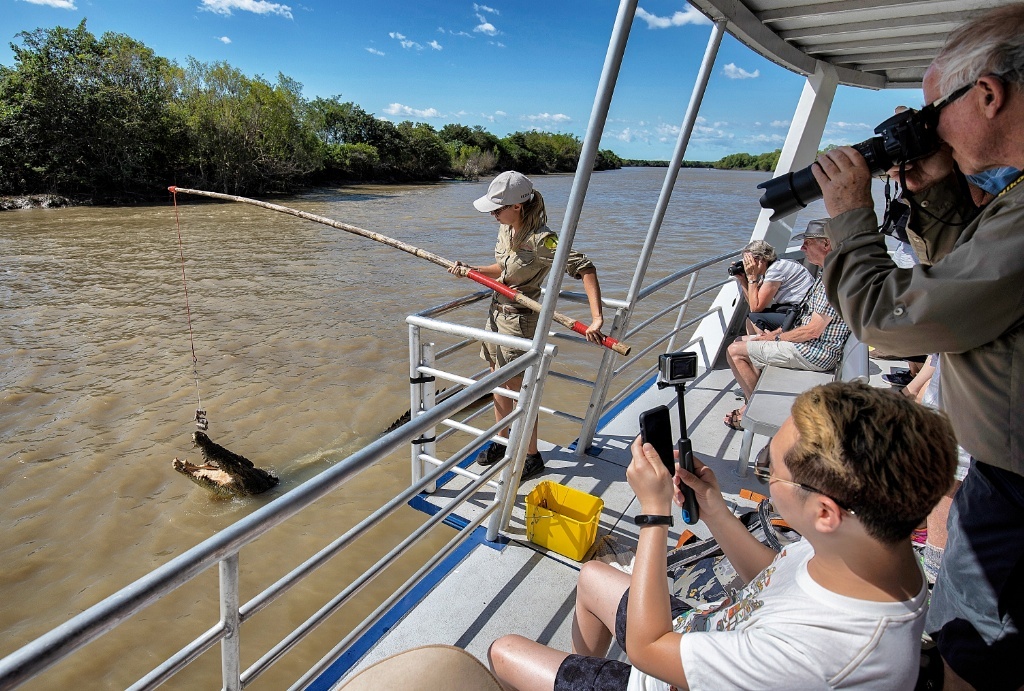
Baiting the croc with buffalo meat. The activity is conducted in a safe manner to ensure a great outing. Guests are informed on the reptilian biology, territorial habits and their importance to the ecosystem. Most of the crocodiles that come to the baiting sessions are so regular that the crew knew every single one of them and called each one by name.
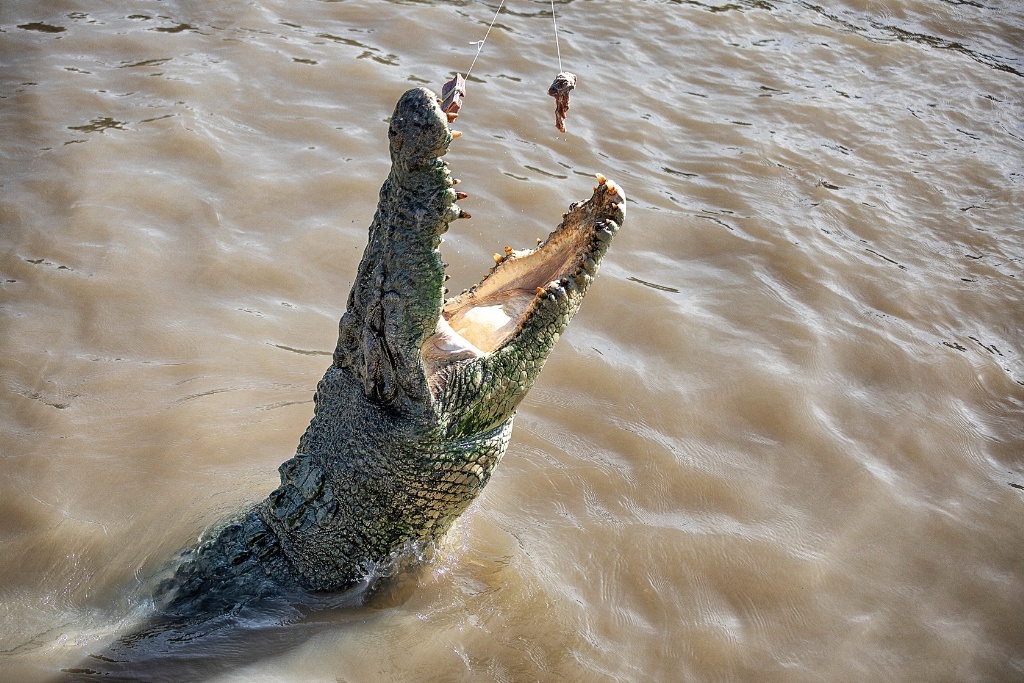
An amazing experience to observe the crocodile at a close yet safe distance. Hearing the loud thumping sound that echoed in the air as the croc jaws slam-locked when seizing the bait, is enough to remind you why they are so feared.
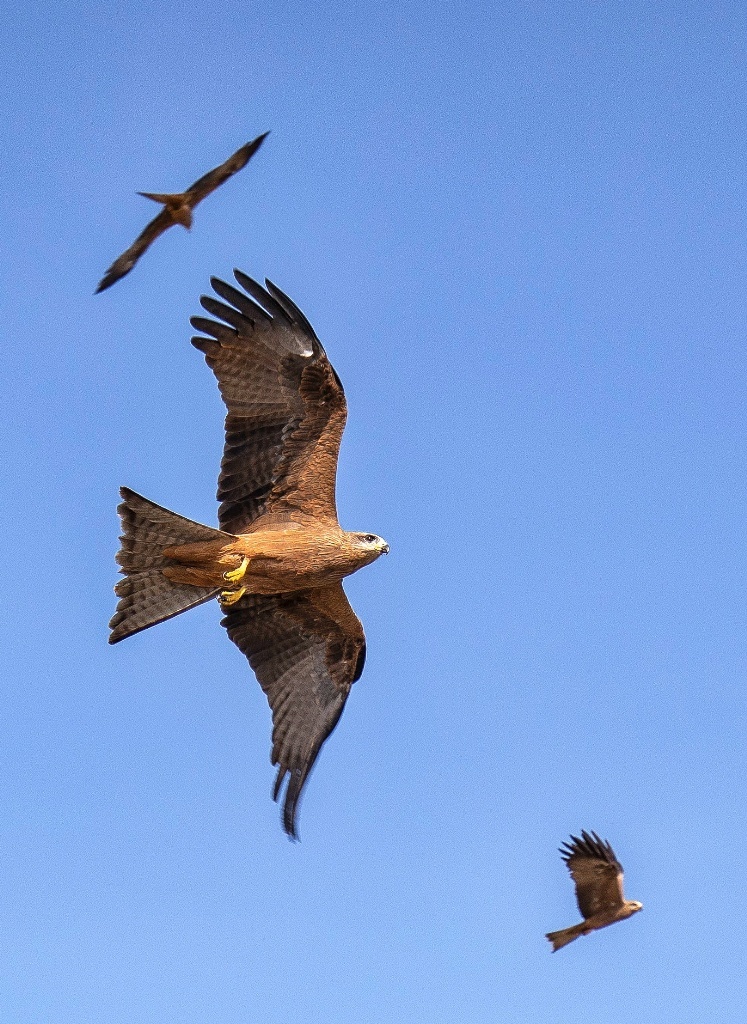
There are also resident colonies of predatorial birds along the river. This flock of kites provided added excitement as the 1.5-hour cruise wrapped up. There must have been at least 2 dozen of them swopping in and out to grab food tossed by the boat captain.

Certainly, a great way to start any NT trips, which many identifies as a “croc region”. As with any tour in Australia, guests can be looked forward to an informative and quality outing. More information on these crocs tours can be referred here.
Wildman Wilderness Lodge*
I don’t usually feature resorts or lodges as part of my travelogue but Wildman Wilderness Lodge is an exceptional end-destination by itself and warrants a special shout-out. After the jumping crocodile activity ended at 4 pm, the drive to this gorgeous lodge took almost two hours. We were just in time to experience the sunset around 630pm. The receding sun bathed the area in a warmish glow and makes for a spectacular ambience, especially when you observe the big colonies of wallabies grazing on the grassland dotted with termites mounds just meters across the lodge. (*This resort is closed for business pending future update as of April 2022)
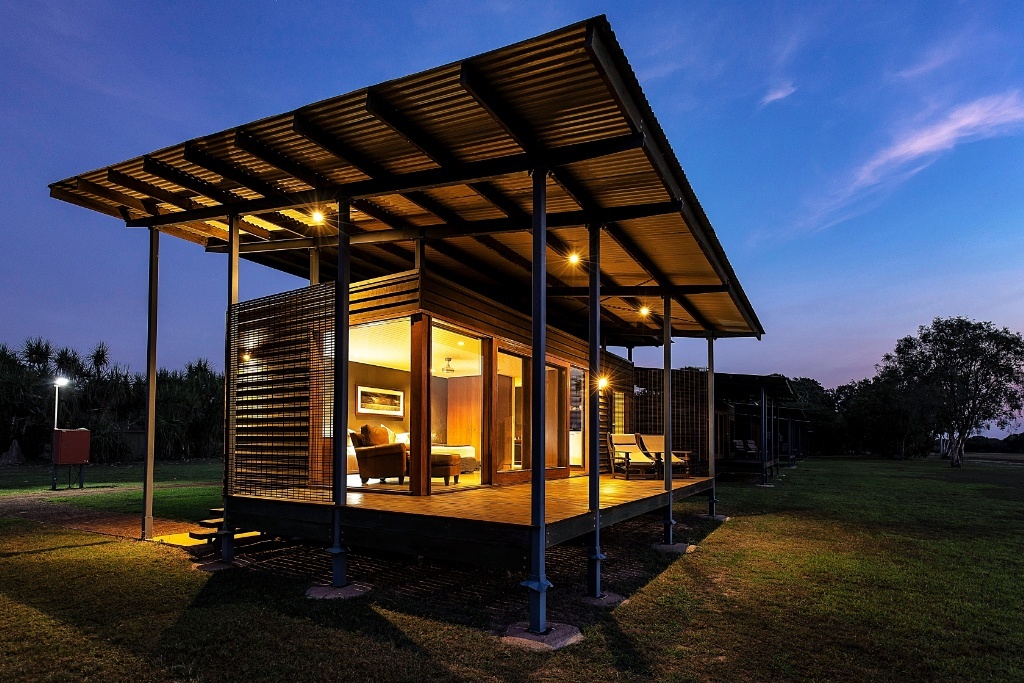
Our accommodation called “Habitats” are described on the resort webpage as “well-appointed, beautifully designed free-standing cabins” which “offer a soothing luxury in air-conditioned comfort, with luxury bedding, premium furnishings and en-suite bathrooms”. I certainly agreed, word for word. There are only ten of these cabins so you will be disappointed if you don’t book well in advance. This room type is limited to twin-sharing.

The lodge swimming pool area. While the sun deck loungers were very inviting, I could not resist going around the shooting pictures as we are only staying here for 1 night.

It was just at the tail end of the wet season, during which the lodge is closed for business. As the lodge re-opened only recently, the lower occupancy meant that we almost had the entire resort to ourselves. In peak season, you can expect the infinity-edged pool to be healthily used.
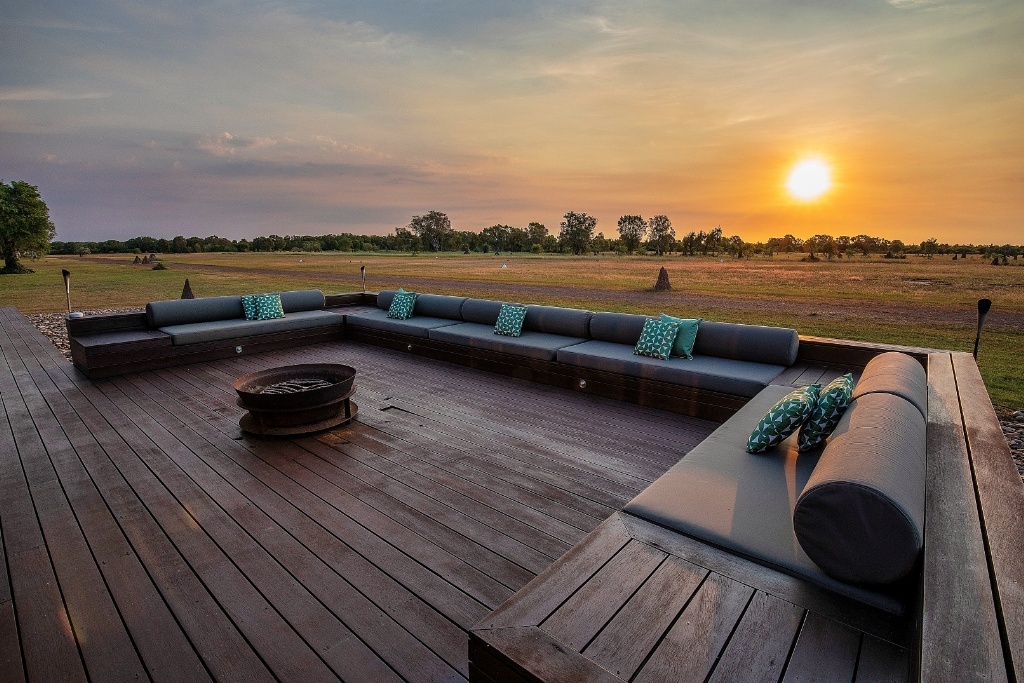
The perfect setting for a campfire after a hearty dinner. The lodge packages include a full board with activities available for customisation.

I like to call this the “St.Regis” of wilderness lodges. You can enjoy the wilderness but still, have the luxury.

The receding sun painted a deeply saturated red-orange glow. I did not enhance the colour and in fact, I had to set slightly darker exposure to accurately convey the richness of dusk, as seen by my eyes.

This is not a Kangaroo but an agile wallaby (also known as the sandy wallaby). Its a species of wallaby commonly found in northern Australia and New Guinea. The agile wallaby has a sandy colour becoming paler below. It alternates between being solitary and sociable as it grazes on the fauna of the land.

One of a flock of Galah birds starting the day right beside the lodge, landing at a sand spot to consume pebbles. Birds don’t have a digestive system that churns their food, do they rely on pebbles to do the process, called gastrolith which is a very common behaviour among ground birds.
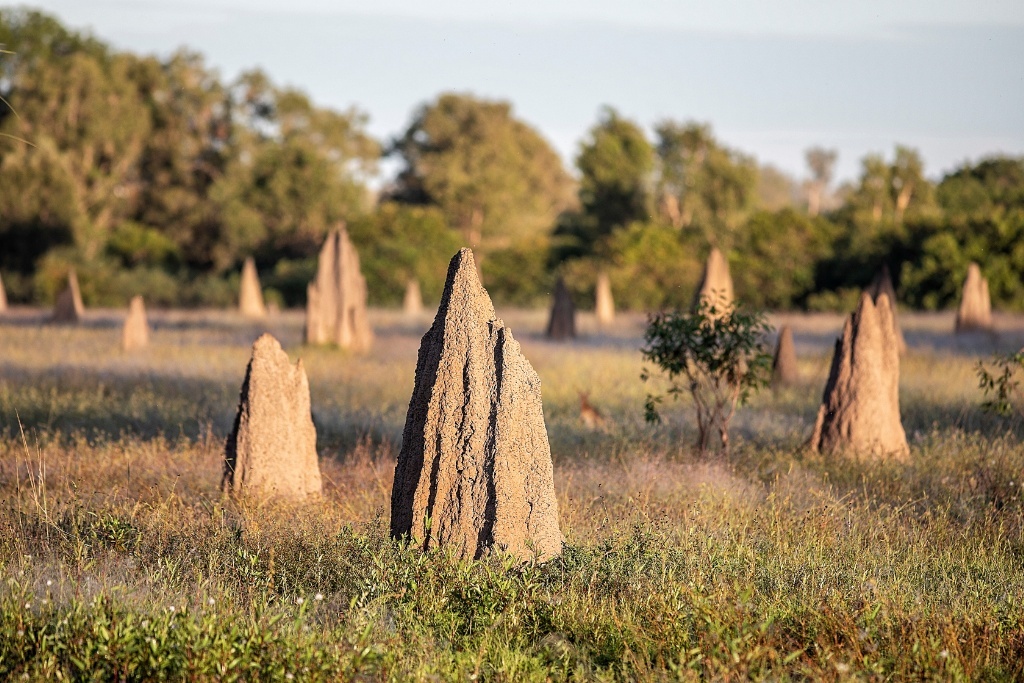
Day #2 saw us waking up early for our AirBoat at 830am tour on the wetlands, just a few mins’ drive from the lodge. I was mesmerised by the Alluvial Termites mounds dotting the landscape. Termites are “ecosystem engineers” promoting soil health and organic decomposition. As such, termites is an important integral part of the land health.

Another type of accommodation at the lodge is the “Safari Tents” which are essentially glamping tents with all the amenities but without air-conditioning. There are only 15 such tents at the lodge. Safari tents cater for families of 4 or 5 people (a maximum of 4 adults in each). The 4 person tent includes a double, a single and a trundle bed. The 5 person tent includes a double, bunk and trundle bed.
Day #2 – Airboat Tour @ the Mary River Wetlands
This airboat tour was definitely one of the highlights of the trip. Amazing wildlife and natural scenery abound at the Mary River Wetlands. The NT wet season transforms the Mary River Wetlands into an inland ‘sea’ and replenishes the earth after the long dry season. Fish, crocodiles and birds breed unhindered at this landmass. As the water subsides in the wet season, the ‘dry’ season creates an awesome spectacle to observe huge numbers of bird species & large crocodiles. A wildlife lover’s paradise bar none.
Perfect for speed junkies, the Airboat is powered by a 350HP Chevy engine. The wetland is about the size of two Singapore combined. And we are the only three people on this vast tract of the watery world. Can’t get any more exclusive than this.
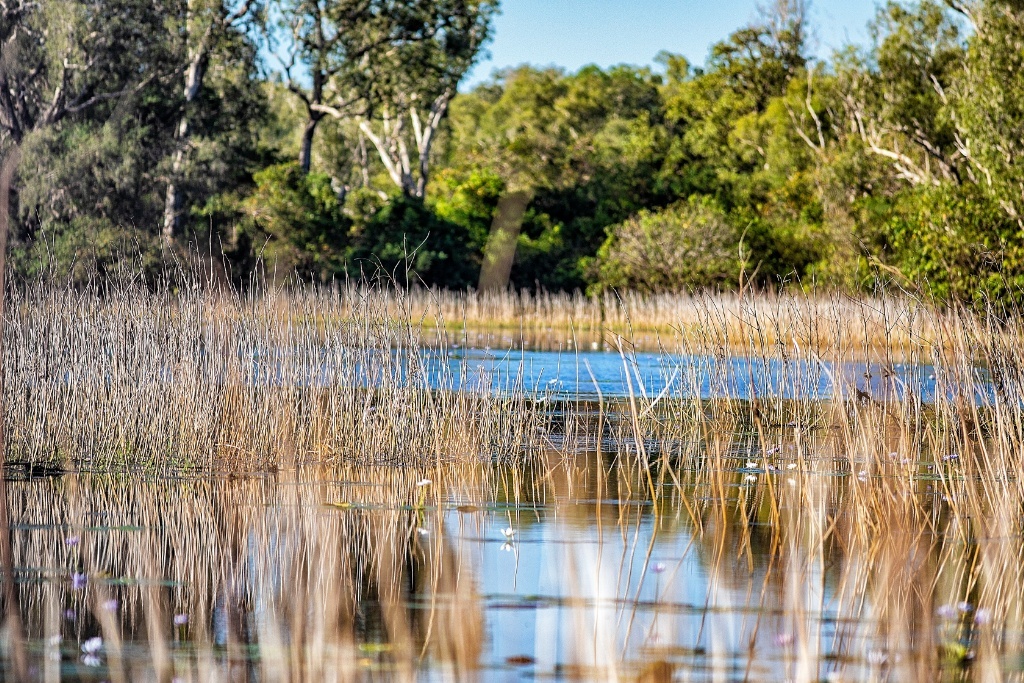
A section of the surreal wetland landscape. For half of the year, the wetlands are flooded, while in the dry season the water level out by evaporation and are baked dry by the sun. The region is one of great contrast.

The Water Lily with its blue, white, violet or pink petals and yellow stamens is one of the most common water lilies in the wetland. The large round two-lobed leaves float on the water to provide shelter and food for large numbers of insects and their larvae. The underside of the leaves and the stems are coated with a furry growth consisting of a tangled mixture of various types of algae which are important as primary producers for small invertebrates.
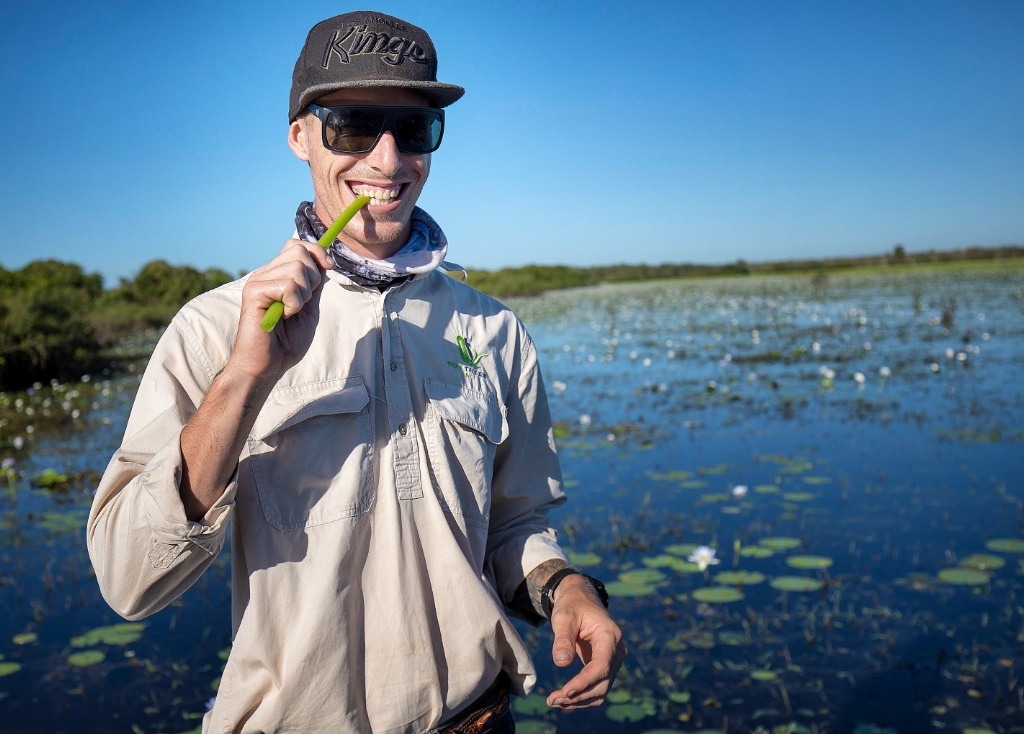
Our airboat captain-cum guide, Jack showed us an aboriginal survival technique by chewing on a water lily stem. It tasted a little bitter but at least you can hydrate yourself.
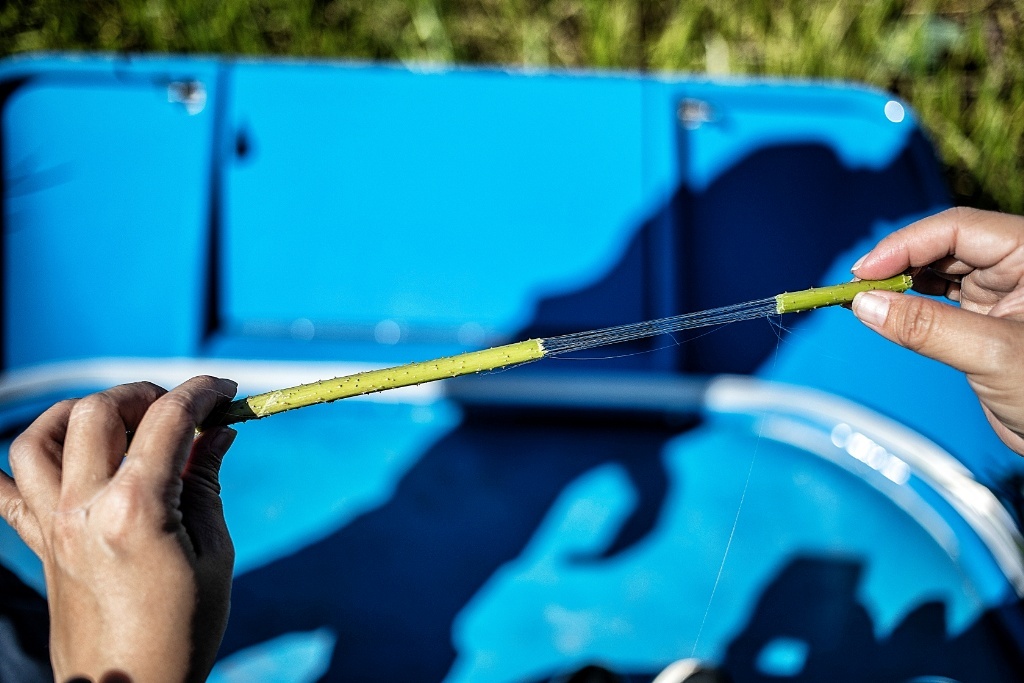
The lotus plant stem contains fibres that can be woven into clothing materials.
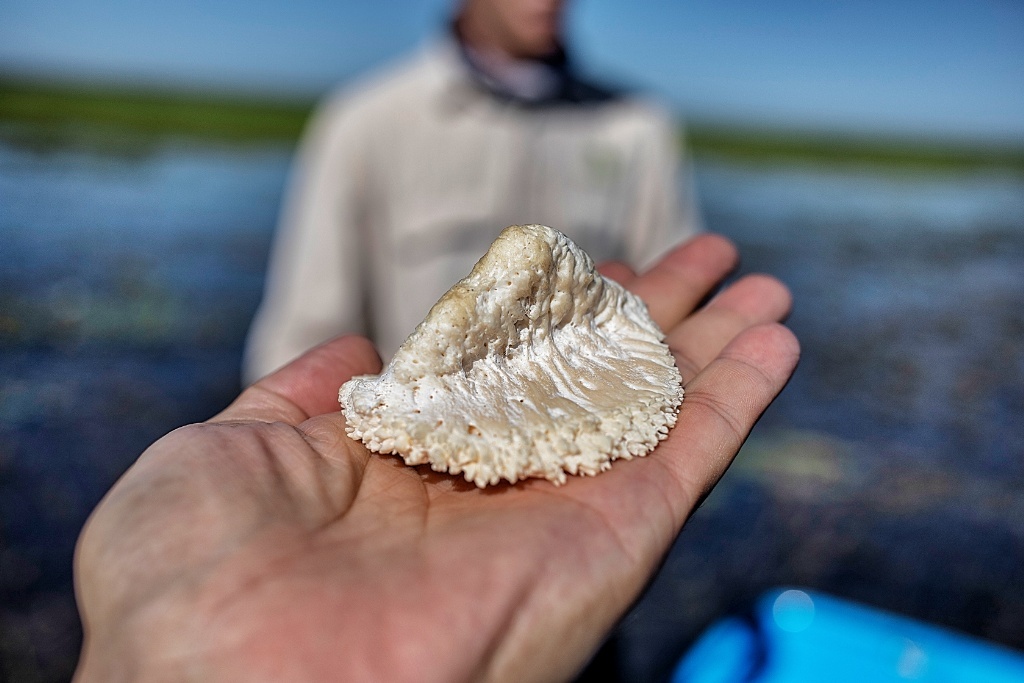
A specimen of the crocodile dorsal spine bones found just behind the eyes.
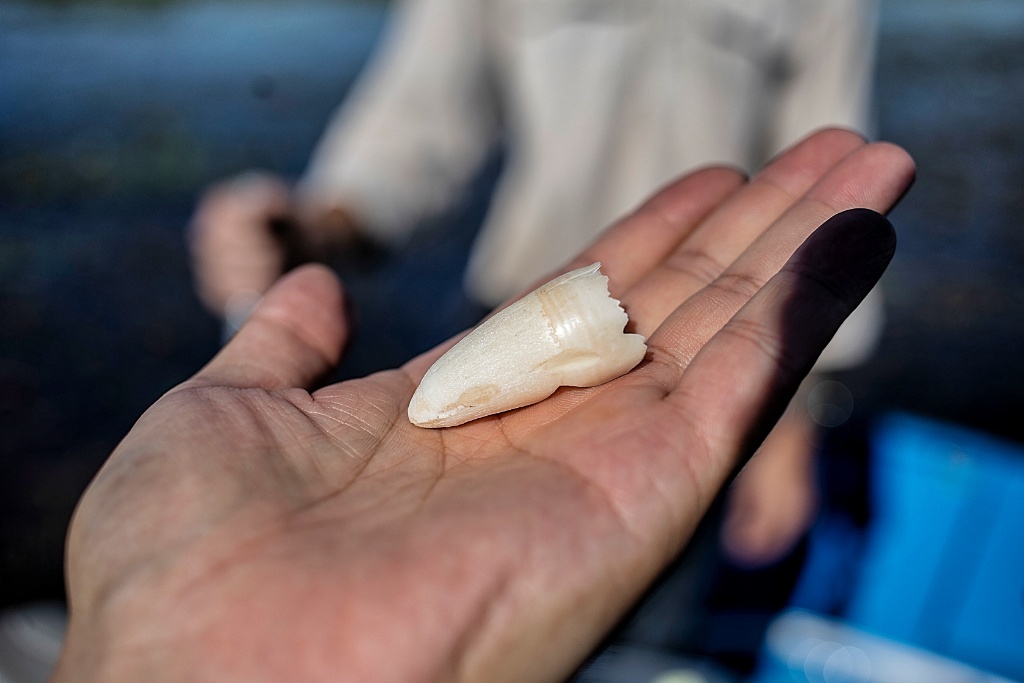
A crocodile teeth specimen. Crocodiles are polyphyodonts, that is, they are able to replace each of their 80 teeth up to 50 times in their 35 to 75-year lifespan. Next to each full-grown tooth, there is a small replacement tooth and an odontogenic stem cell on standby that can be activated if required.
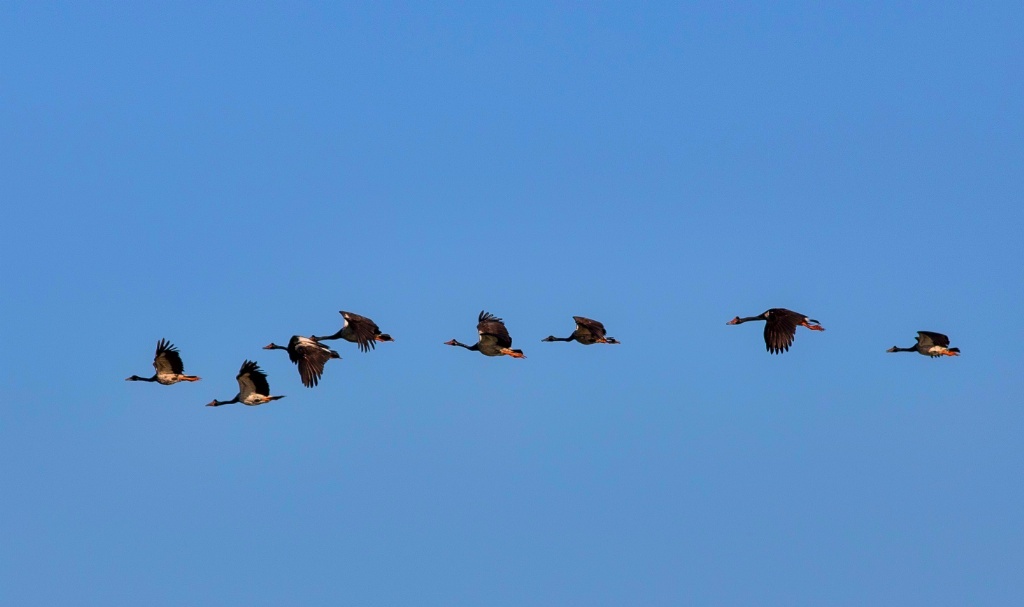
A flock of Magpie Geese flying over the wetland. Magpie geese are unmistakable birds with their black and white plumage and yellowish legs. Their call is like loud honking.
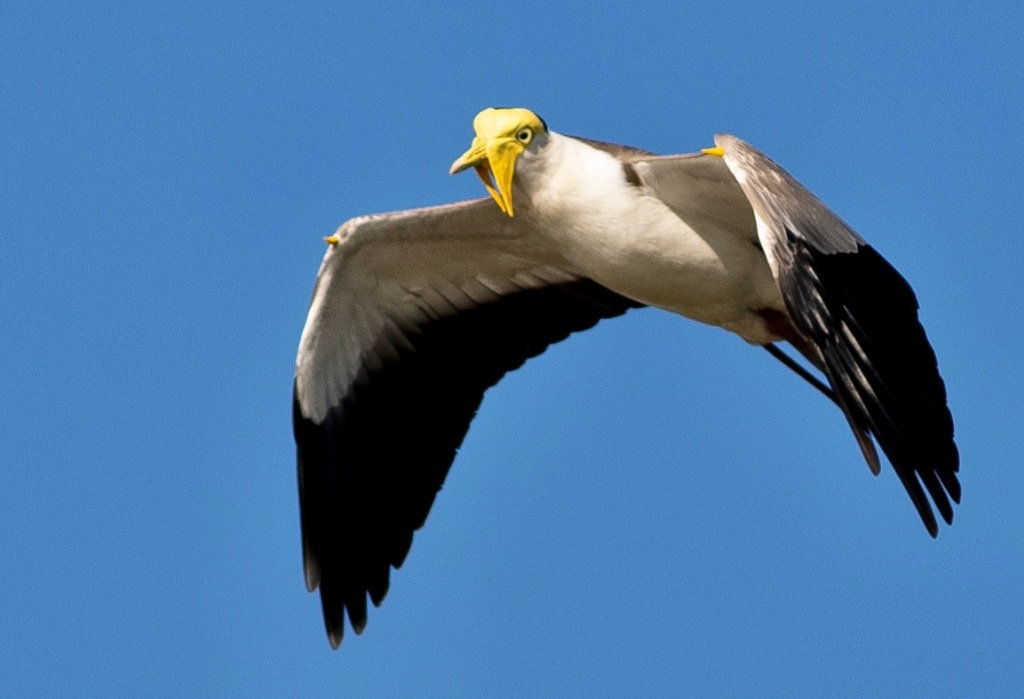
A Masked Plover in flight. It is a large, common and conspicuous bird native to Australia, particularly the northern and eastern parts of the continent, New Zealand and New Guinea. It spends most of its time on the ground searching for food such as insects and worms and has several distinctive calls.

A Darter bird sunning itself in the morning sun, to dry out the waterlogged feathers during food hunt on the water. Their preferred mode of flight is soaring and gliding while in flapping flight, they are rather cumbersome.
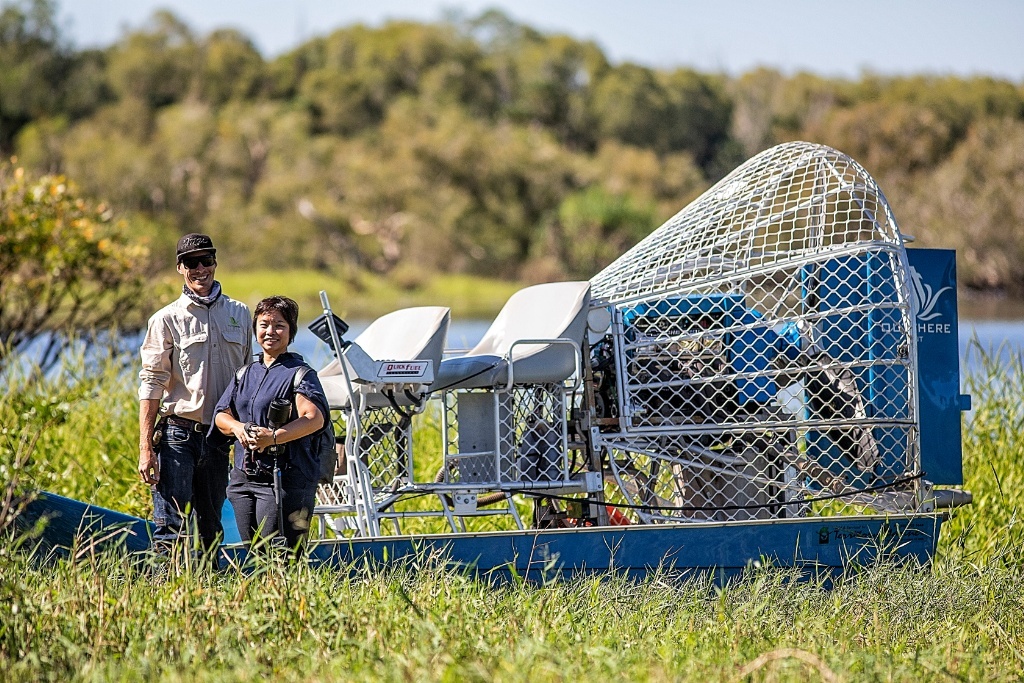
Travel mate Cindy with our boat captain Jack. Just had to grab this picture to show what the airboat looked like.
Day #2 – Aboriginal Rock Art @ Ubirr
After the Airboat cruise, we quickly check out of Wildman Wilderness Lodge and drove slightly over 2 hours to Bowali Visitor Centre for our prearranged briefing as we were on a media visit. Filming at the park is subject to approval as the videos we filmed are used for promotional materials. From the visitor centre, it’s about another 1 hour (42km) to the famous Aboriginal Rock at Ubirr.

En route to Ubirr, we encountered a slightly flooded road with about 60-70cm depth, which the 4×4 Mitsubishi Pajero overcame with ease. The car even enjoyed an undercarriage wash in the process. This happens as we are at the tail-end of the wet season.
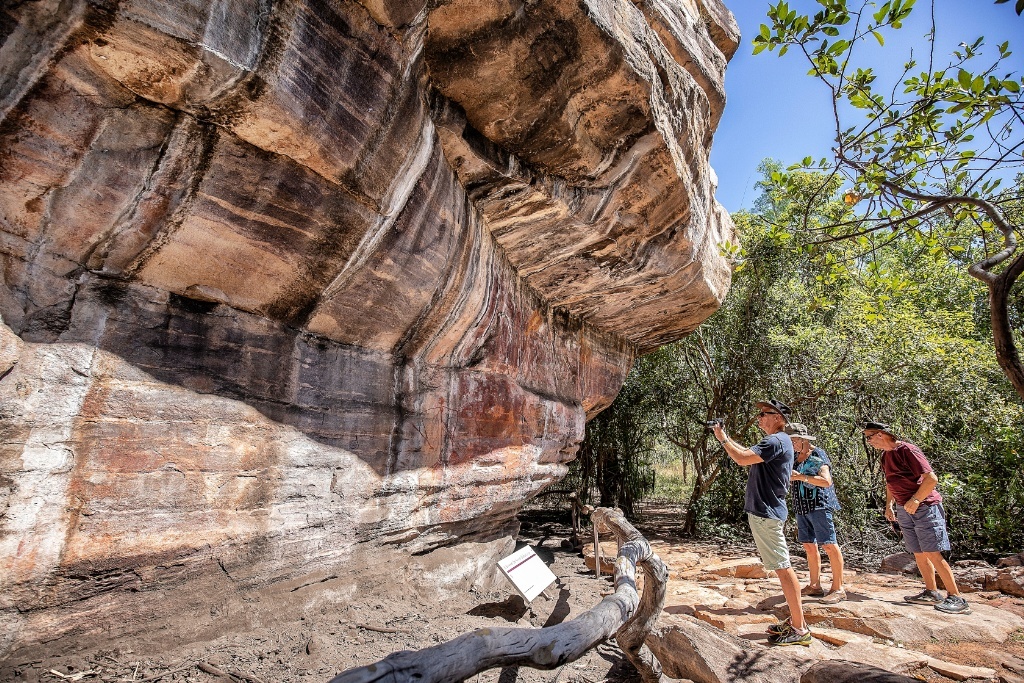
Long ago, the aborigines camped beneath Ubirr’s cool rocky shelters and harvest the plants and animals of the nearby floodplain and East Alligator River for food, tools and medicine. The smooth stone surfaces were perfect for painting on. Ubirr’s rock art is considered among the best in the world.
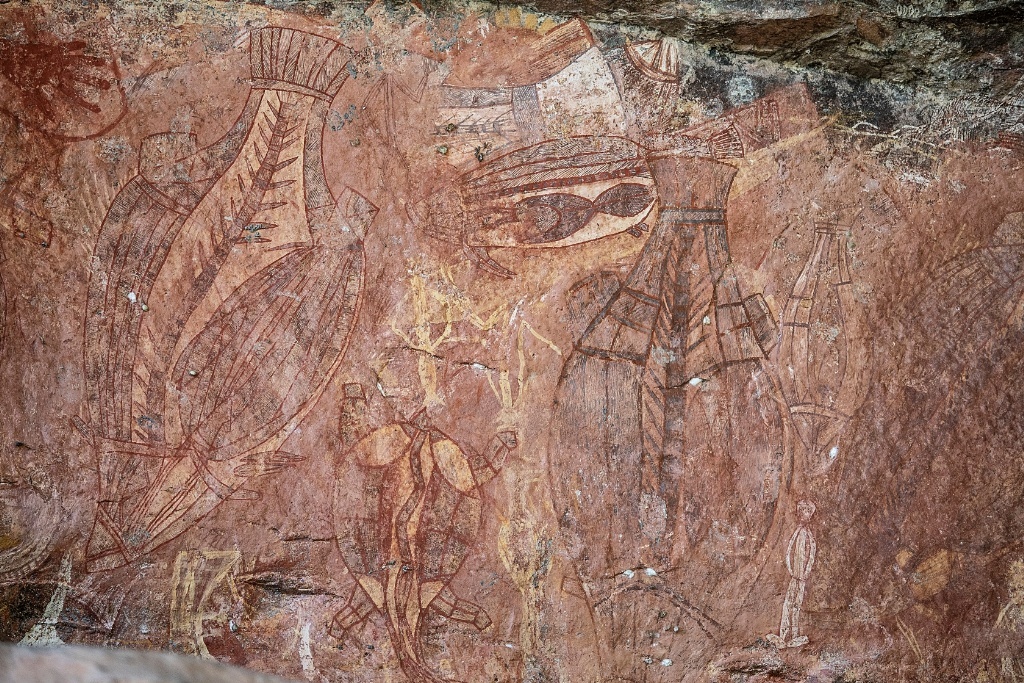
Much of the art here features fish, turtles, goanna and other important food animals. At the main gallery, a painting of a thylacine (the Tasmanian tiger, which became extinct on the mainland more than two thousand years ago) is a rare treat and gives an idea of the age of some of this art.
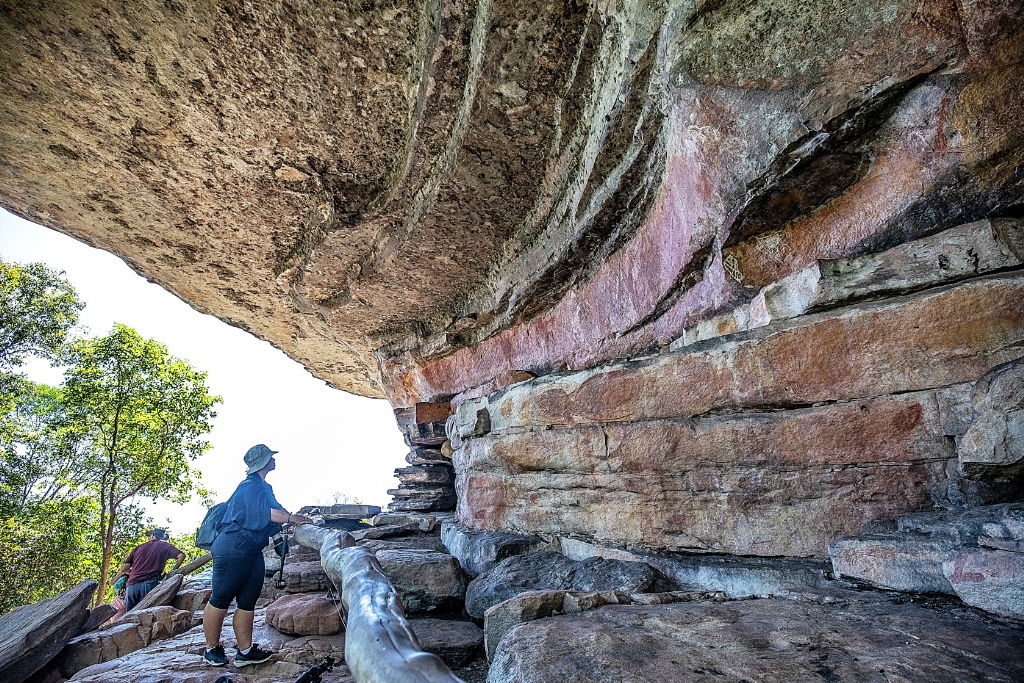
How can we face the future if we do not know the past? “Life can only be understood backwards but it must be lived forwards.” – Søren Kierkegaard
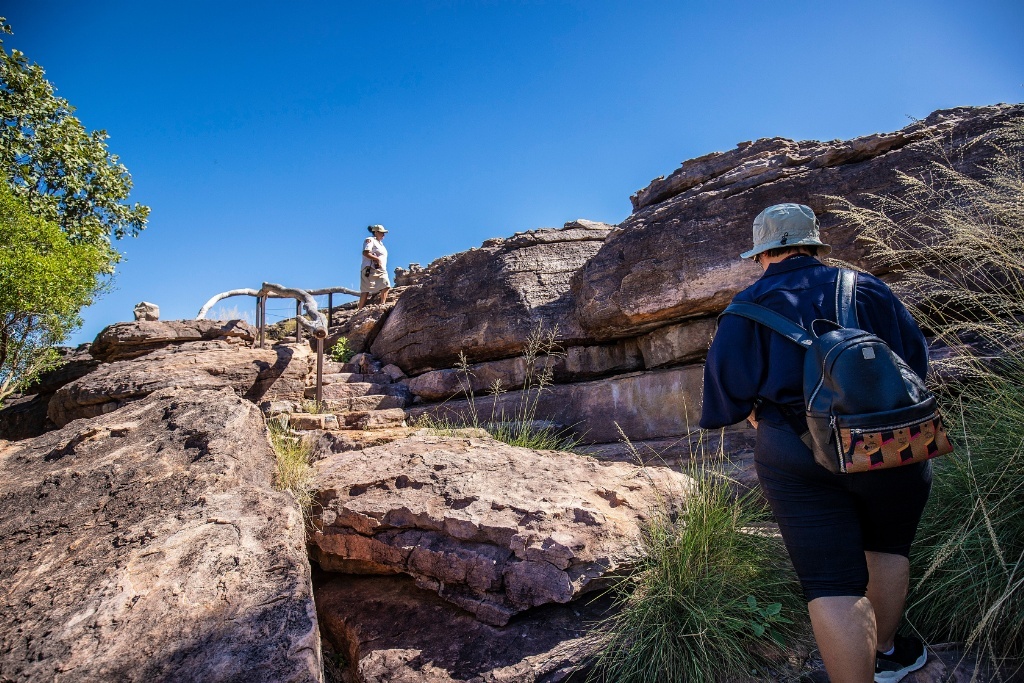
The 1 km circular track which took us past the rock art sites culminates in a steep 250 m climb to a rocky lookout with 360-degree views of Arnhem Land and the Nadab floodplain. This trekking took slightly over an hour if you want to sit on the lookout and savour the views. But during the afternoon sun, look for small overhangs for shade if you intend to stay longer. Three tips to remember on this walk – 1) bring a sun hat 2) bring a bottle of drinking water 3) At the climbing phase, follow ‘Yellow Triangle’ markers embedded into the rock to guide you for an easier climb.

This is the time when lugging a tripod is worth the trouble as I did a panorama shot of the scene. I know a Smartphone app can do the job easily but high-res pictures are the way to go.

According to the aborigines, this is the “most sacred site at Ubirr and is traditionally a women-only site, although this rule is relaxed for non-indigenous tourists. This is the spot visited by the Rainbow Serpent or “Garranga’rreli”, during her path across the top end of Australia, during the Dreaming. As she crossed the land, she “sang” the rocks, plants, animals, and people into existence. This path is still a sacred path to the indigenous people who live in northern Australia” (excerpts from Wikipedia). The view from this beautiful spot certainly justified the climbing.
Day #3 -Yellow Water Cruise @ Kakadu National Park
Day 3 morning saw us at Kakadu National Park (A UNESCO Heritage Site) via Yellow Water Cruises. This cruise is one of the must-do activities as Yellow Water Billabong is at the hub of Kakadu, offering a spectacular journey through the region’s wetlands with its vibrant wildlife and ever-changing landscape. Kakadu National Park is an enormous, biodiverse nature reserve in the Northern Territory. With terrain encompassing wetlands, rivers and sandstone escarpments, it’s home to some 2,000 plant species and wildlife from saltwater crocodiles and flatback turtles to birds. This cruise itself sealed its position as our no.1 highlight on the entire trip.

Our ‘accidental’ missing out of the day 1st cruise at 6.45am turned out to be a blessing as the next scheduled cruise saw only four guests (including us) on the boat designed to carry 40 passengers. During our pre-trip briefing by Tourism NT, we were told the cruise here is like a going through a National Geographic documentary. It was certainly not an exaggeration.
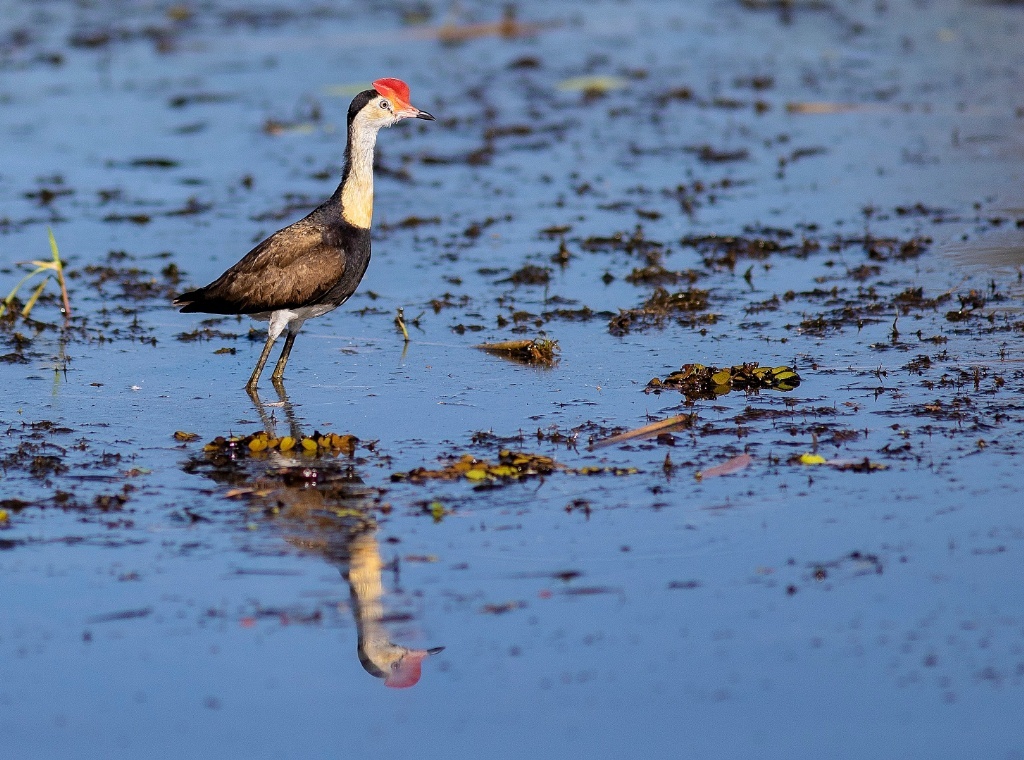
One of the 1st birds we spotted on the cruise – a beautiful Comb-Crested Jacana. This bird is also known as the lotus bird or lily-trotter. Like other Jacana species, it is adapted to the floating vegetation of tropical freshwater wetlands.

A black Kite hovering above us looking for breakfast. Kites, which most mistook for eagles, are birds of prey in the raptor family. Black kites are most often seen gliding and soaring on air currents as they search for food.

A flock of white-crested cockatoos flying around the wetlands. There are huge colonies of this species of bird in the wetlands.
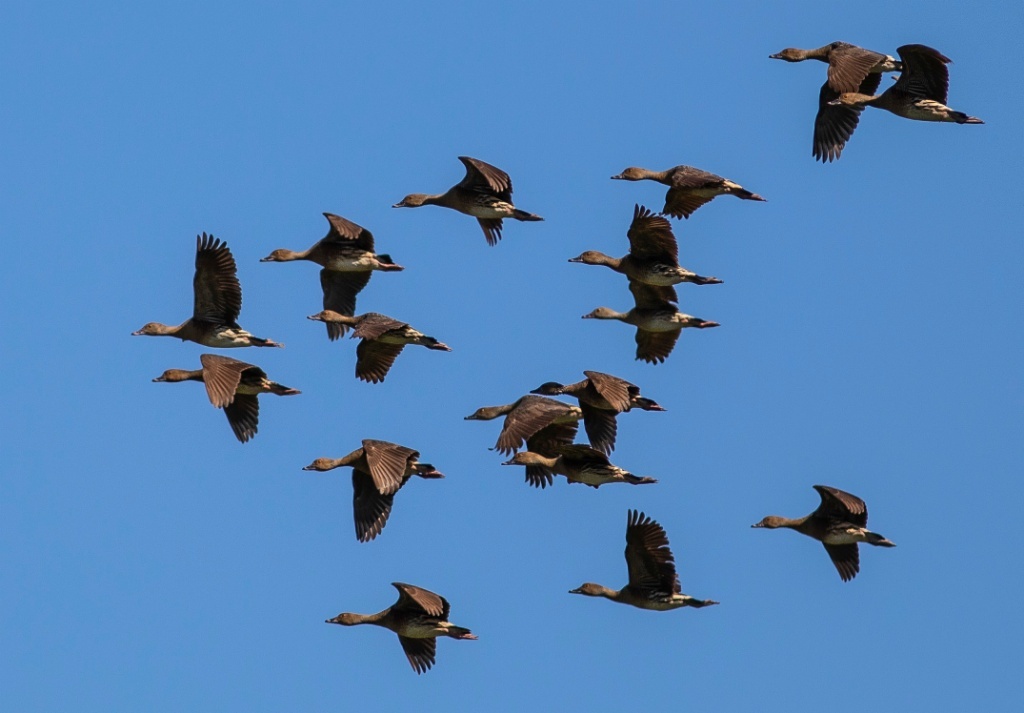
A flock of water ducks flying in formation over the wetland. Scenes like this are common when we cruise along the billabong.
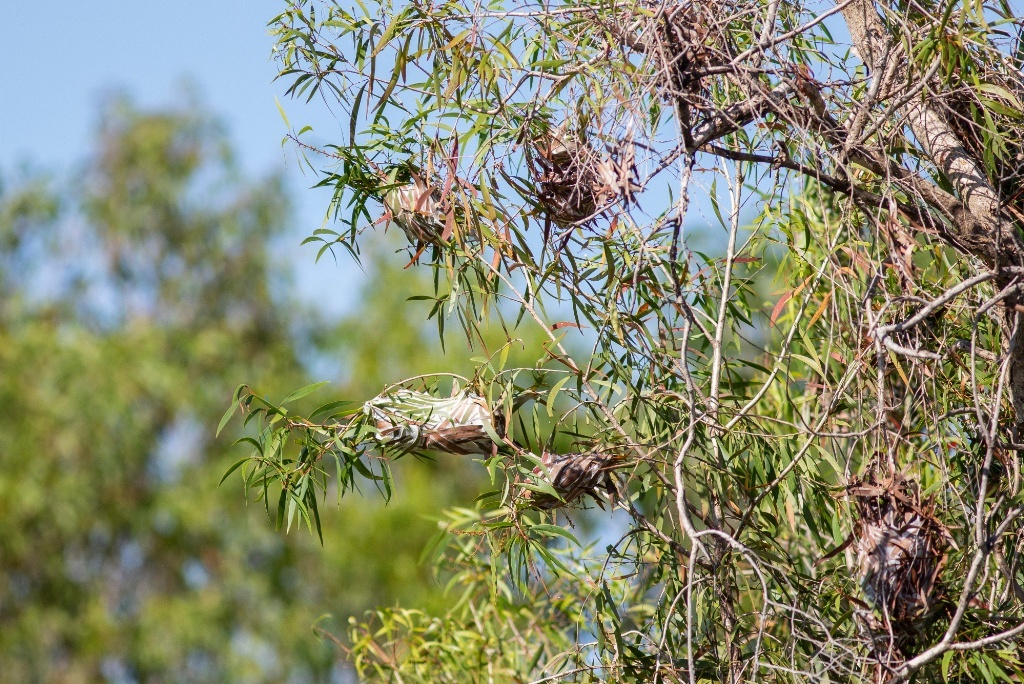
A group of lemon ants nests among the branches. I had previously tasted the lemon ants in Adelaide Central Market. Surprisingly, it has a refreshing lemony taste.
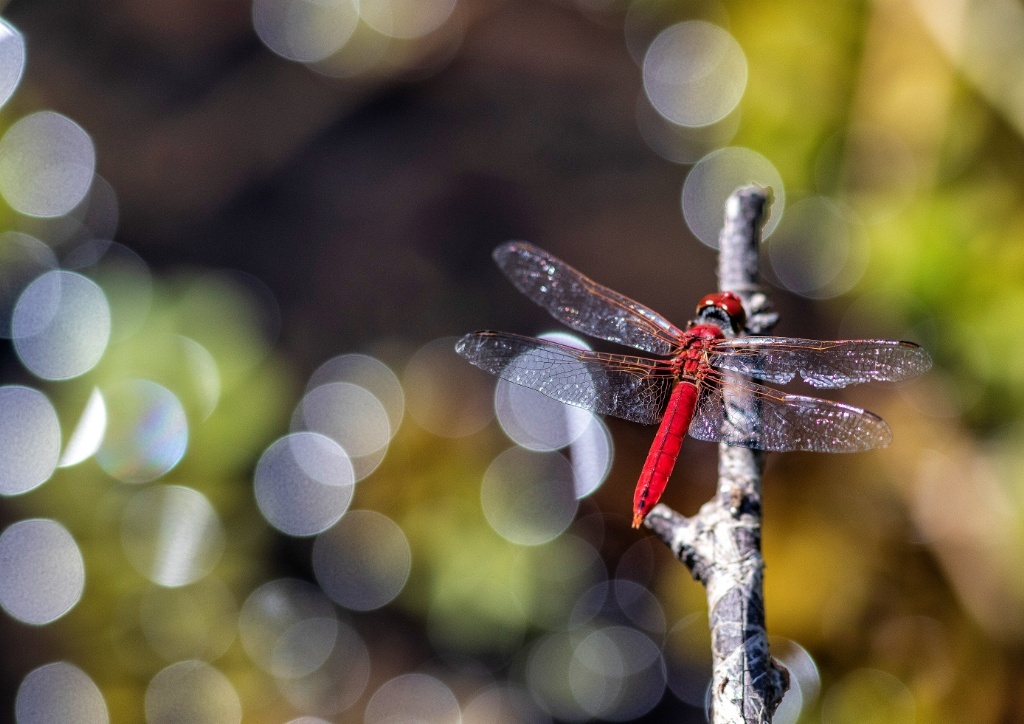
There are numerous species of dragonflies and damselflies in the wetlands. Their larvae helped to keep the mosquitoes population at bay.
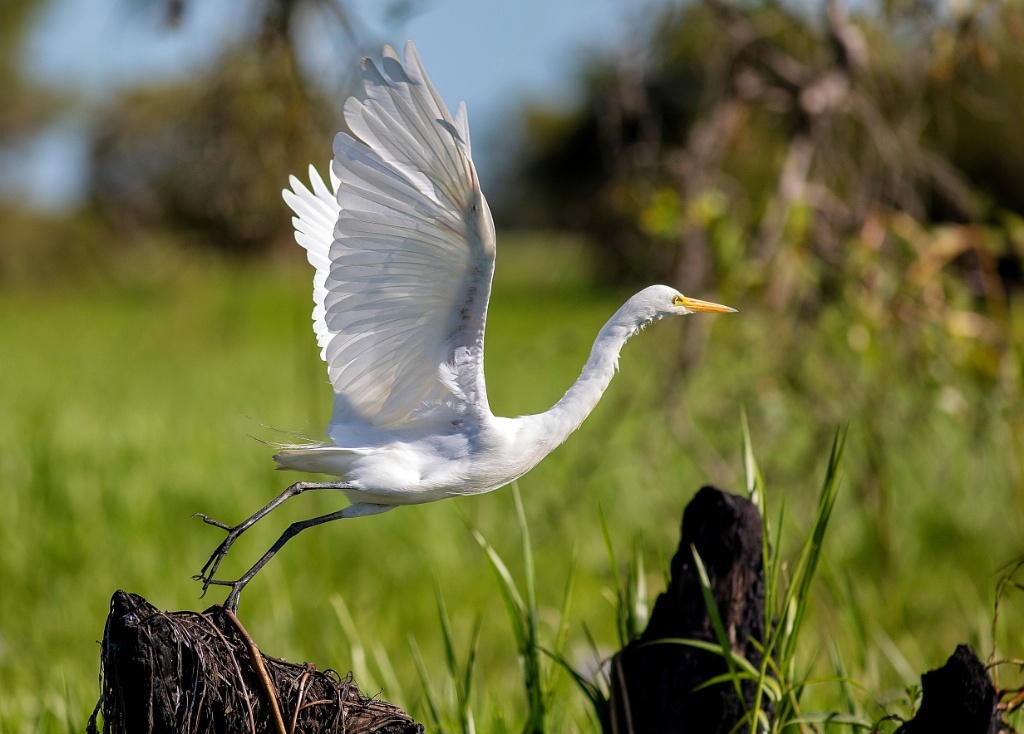
An Eastern Great Egret taking flight. One of Australia’s most elegant birds, the snowy-white Eastern Great Egret is often seen wading in a range of wetlands, from lakes, rivers and swamps to estuaries.

Amazing wild white-crested cockatoos colonies in this section of the wetlands, there were hundreds, probably thousands of them.

If you felt being watched, you are not alone. The Yellow Water Billabong is part of the South Alligator River system but there are no alligators in Australia (an early explorer misidentified crocs for alligators but the name has stuck ever since). This is a salt-water croc, much bigger and more aggressive than the fresh-water crocs found in other parts of Kakadu National Park.
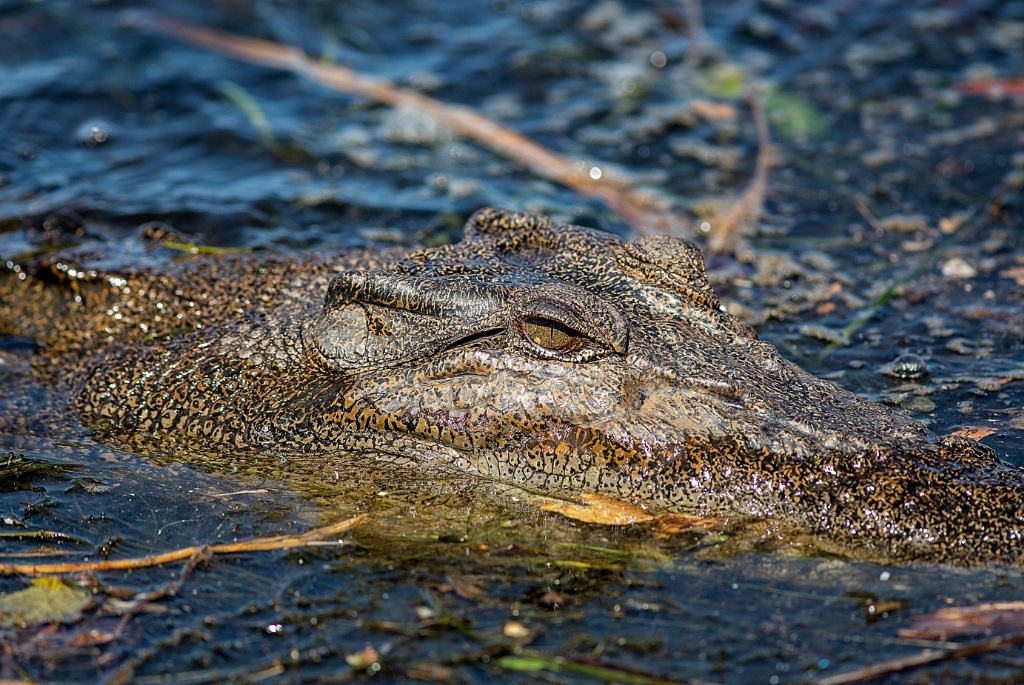
Crocodiles are able to blend into their surroundings and move over extremely large distances on land and water. As an apex predator, saltwater crocodiles are a critical part of the aquatic ecosystems. If crocodiles are removed from these systems, the balance of these systems will change considerably.
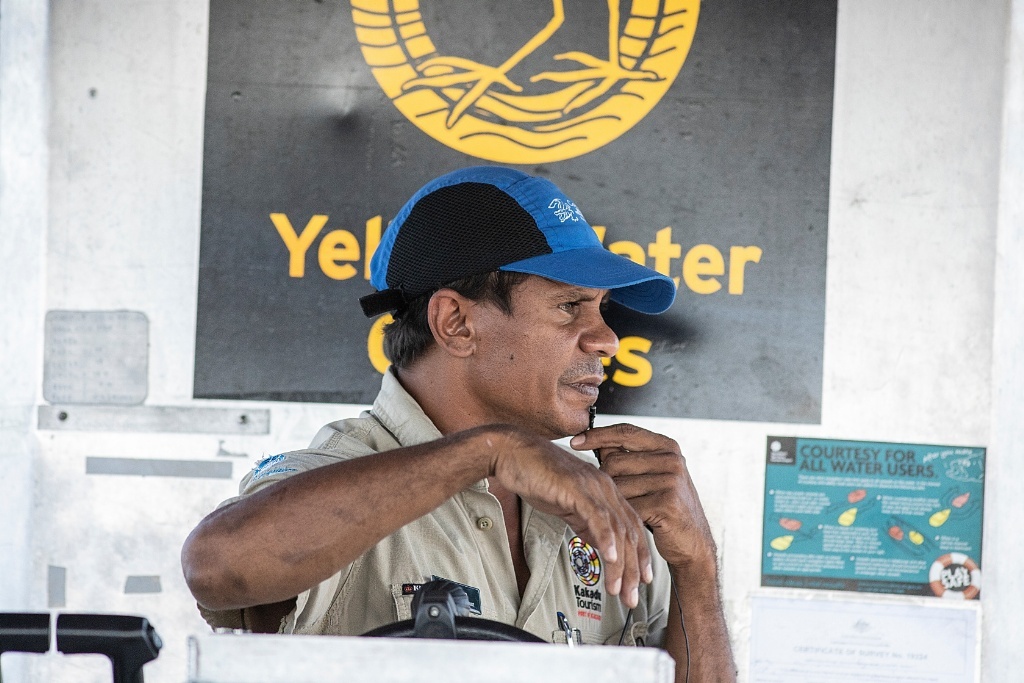
Our aborigine wetlands guide, Don, made the cruise both an interesting and informative experience with their in-depth knowledge of their home ground.
Cicada Lodge @ Katherine
After the Yellow Water Cruise, we checked out of the Cooinda Lodge Kakadu and drove 3.5 hours along Stuart Highway to the fabulous luxurious boutique accommodation called Cicada Lodge at Katherine. Cicada Lodge walking distance to the Nitmiluk National Park (which we were visiting the next day), makes it the perfect choice of accommodation. I feature this lodge as its quality and ambience will appeal to many travellers.
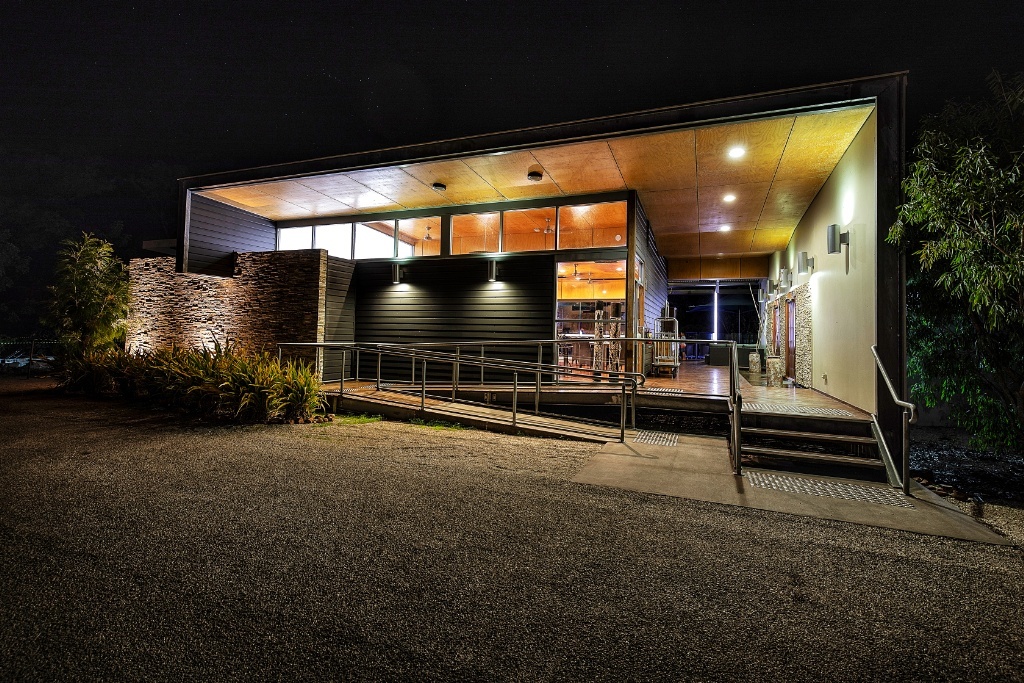
The lodge facade at night. I always like Australian design for its modernistic yet functional appeal.

The lodge swimming pool, where canapes are served daily evening by the poolside.
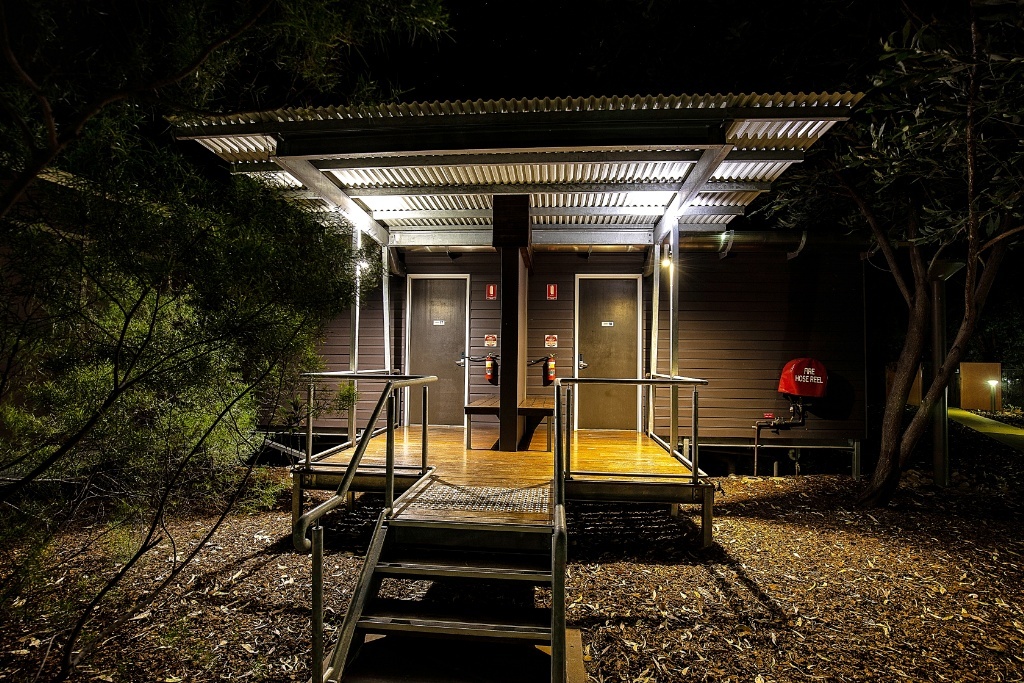
Our cabins at the lodge. And behind that door, as described on the resort webpage, a “sanctuary of elegant comfort”. The lodge may be named Cicada Lodge, but we were not disturbed by any cicada cries. Anyone looking to manage cicada problems at their house might refer to this useful website.

There are only 18 rooms at this lodge, with full-length louvred doors to the private balconies, allowing guests the choice of opening their room to the sounds and sights of the native bush or closing them for the privacy of the room. Indigenous artworks from local artists are also featured in each room. Wifi signal was good and the excellent bed gave good sleep quality.

Nicely prepared canapes are served before dinner.
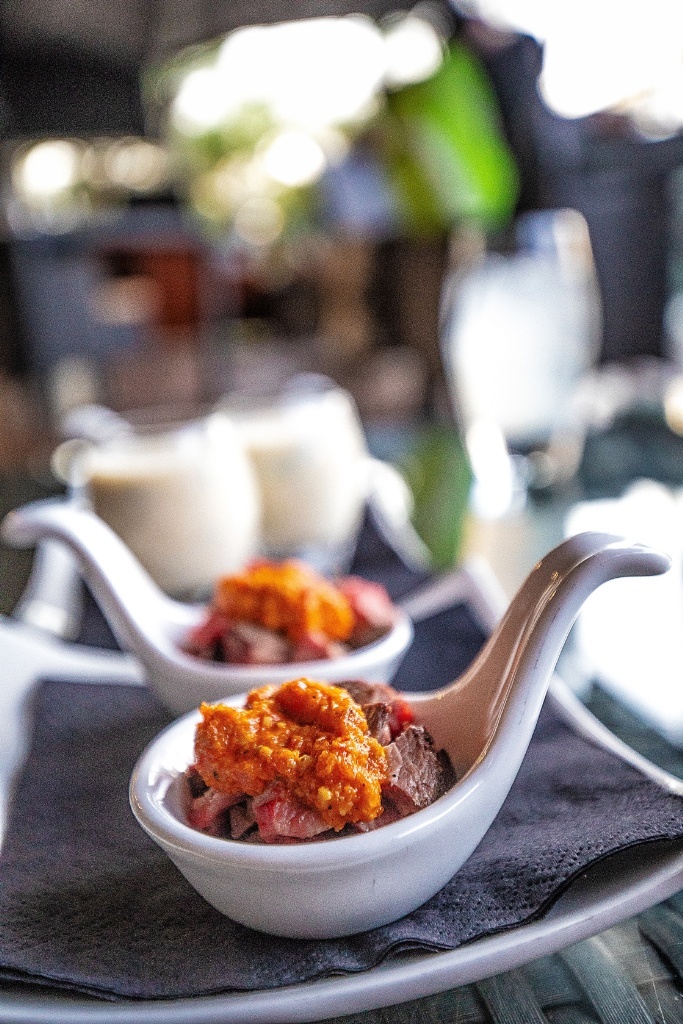
Does this whet your appetite for dinner?
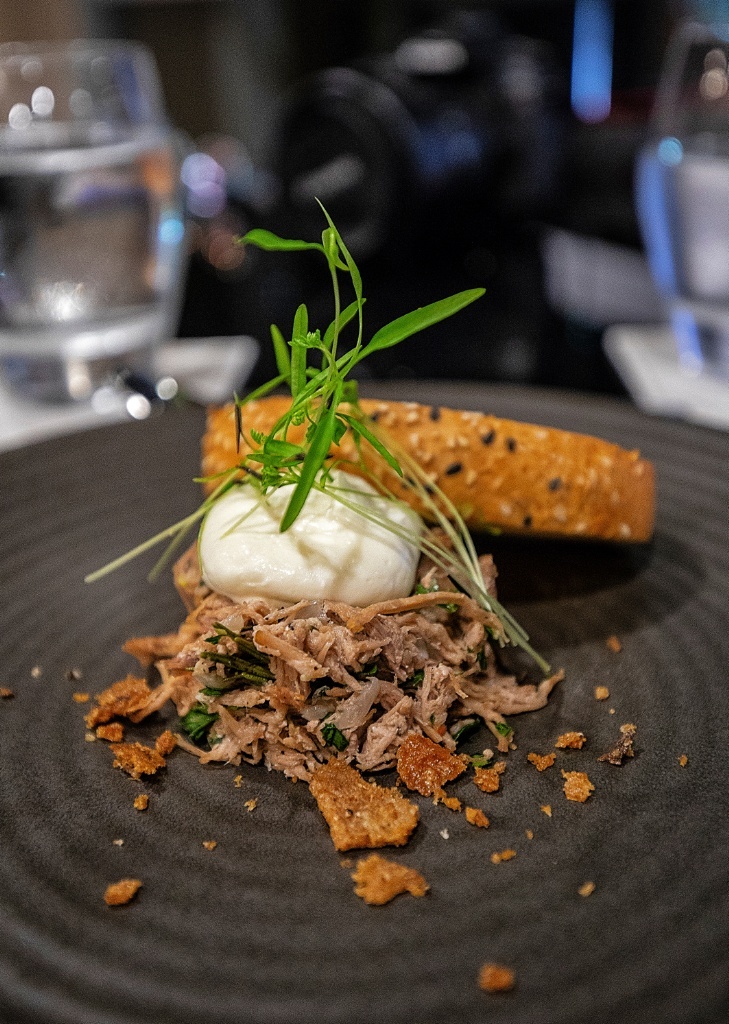
Dinner entree – Shredded beef with garlic bread. The secret in the lime moose. The meals at this lodge certainly maintained the exquisite feel of staying here.

I don’t usually eat fish but this pan-fried Barramundi was done perfectly. The Northern Territory has the largest numbers of barramundi in Australia, providing an abundant supply for local consumption and export.
Day #4 – NitNit Dreaming 2 Gorge Cruise @ Katherine Gorge
Our day 4 adventure brought us to the beautiful gorges at Nitmiluk National Park (Nitmiluk is the Aboriginal name for Katherine Gorge). There are 13 gorges at the park but a 2 hours cruise with Nitnit Dreaming 2 Gorge Cruise will let visitors discover the cultural significance of two gorges to the traditional landowners- the Jawoyn people. The cruise guide will regale you with the history and traditions of the Indigenous inhabitants. In Jawoyn, Nitmiluk means “place of the cicada dreaming“.
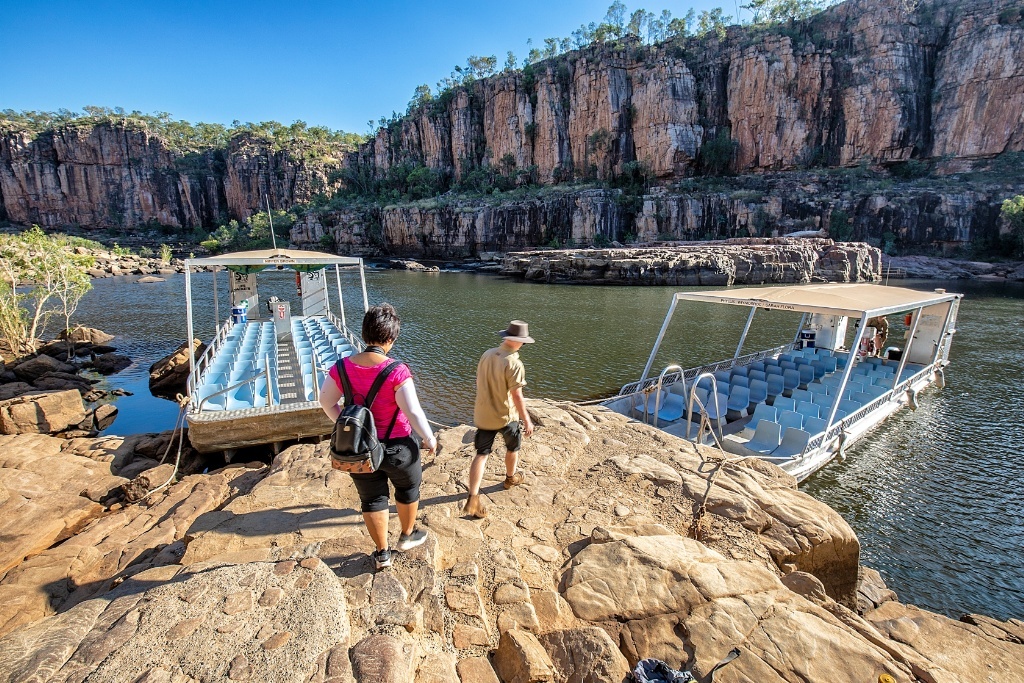
Between Gorge 1 and 2, we were treated to a 500m trail walk along a man-made, uneven path as part of the cruise experience. The view along the trail is pleasant and offers some photographic opportunities.

Early morning view along the cruise. The experience is both tranquil and soothing as the natural scene changes along the way.

It took 23 million years for the Katherine River to form this natural wonder. Truly a geographic lover’s paradise.

Rock arts were painted by the Jawoyn inhabitants. Such paintings sent you back 40,000 years ago. Imagine the history of this sandstone country.
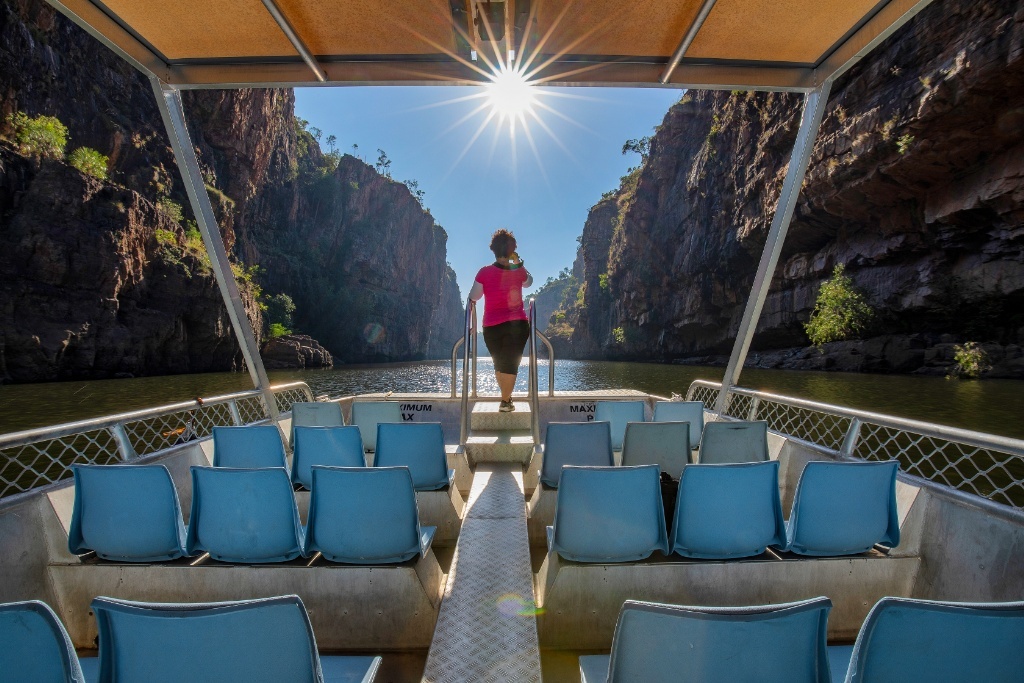
All the good things happened here, we were 2nd time lucky (the previous was the Yellow Water Cruise) as there were no other passengers on our 9 am boat departure, making us feel as if it was a private chartered cruise.
Day #4 – Litchfield National Park
After the cruise at Katherine Gorge, we make haste to check out of Cicada Lodge as our next destination, the Litchfield National Park, is about 3.5 hours (310 km) drive away. This park spans some 1500 km² in size and is famous for its waterfalls and termite mounds. This park visit marks the final phase of attractions in the outback before we return to Darwin on the homebound phase.
Termite Mounds

We were treated to the sight of a mind-boggling gigantic “Cathedral Termites” mound in the Litchfield National Park. This termites mound, in comparison with human beings (worker termites stands about 3mm in height), is the equivalent of 4 Burj Khalifas stacked on top of each other

At the Magnetic Termites Mounds at Litchfield National Park. The termites are endemic to northern Australia and the common names derive from the fact that the wedge-shaped mound is aligned with its main axis running north and south, to harness the energy of the sun. This termite site is out of bounds and can only be observed from atop a boardwalk. The park permits to use our drone came in at a most useful juncture.
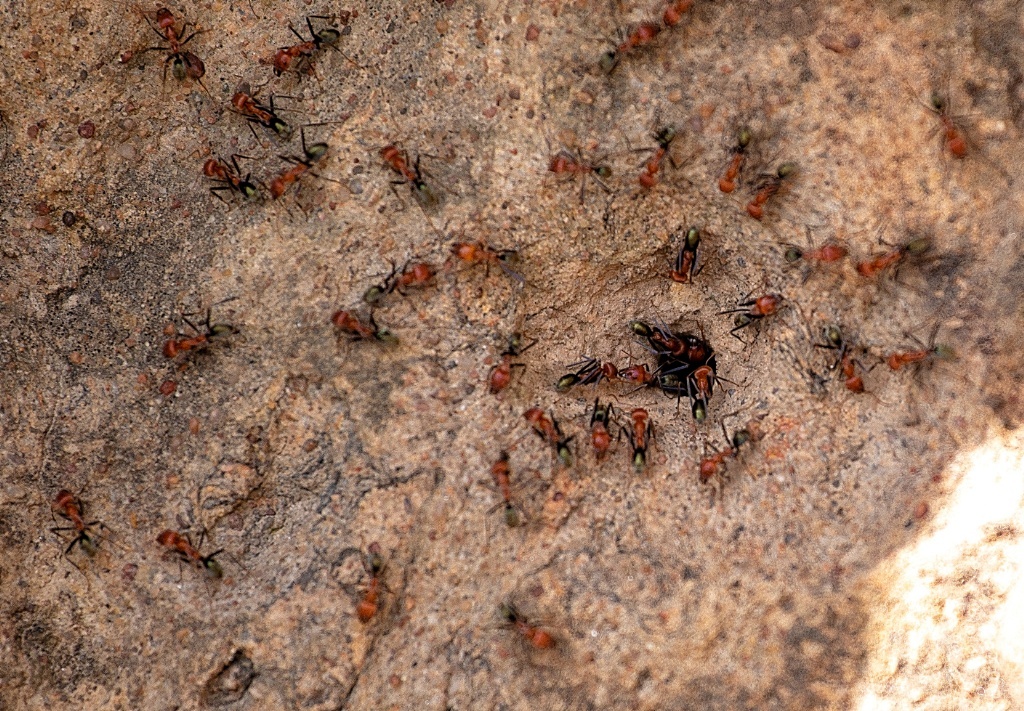
The reality of nature sets in, these are not termites but predatory ants attacking the termites through the mound ventilation holes. But the termites colonies are more than able to defend themselves.
Buley Rock Hole
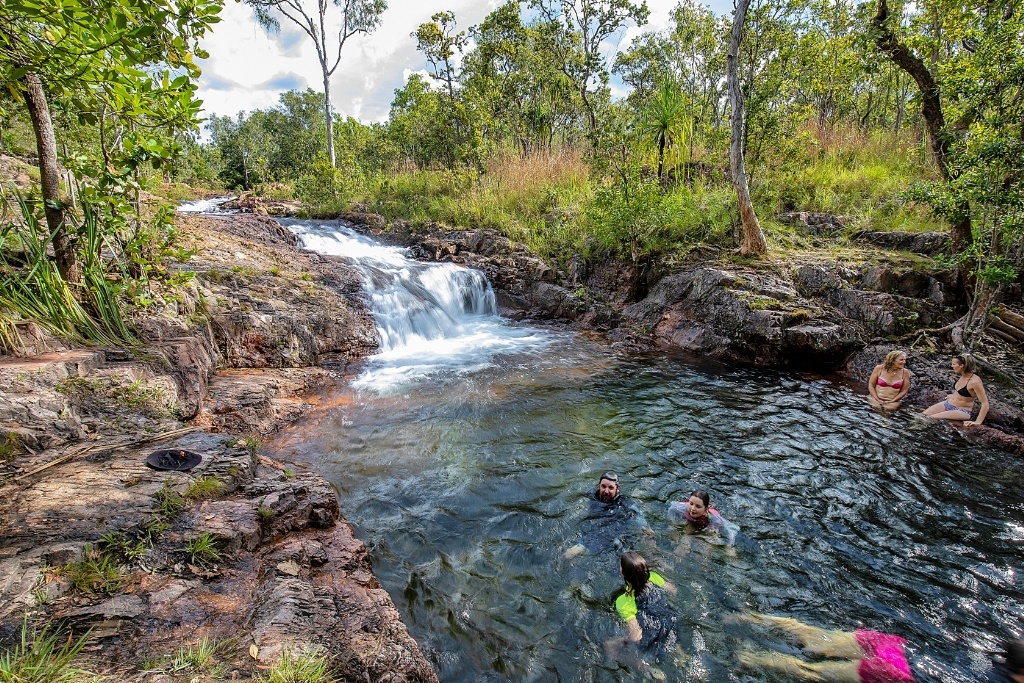
This is awesome for cooling down but our tight schedule meant we only spent a few minutes here, grab some shots before we return to Darwin. It is not advisable to drive after dark as there is a higher chance of roadkill in the pitch dark surrounding.
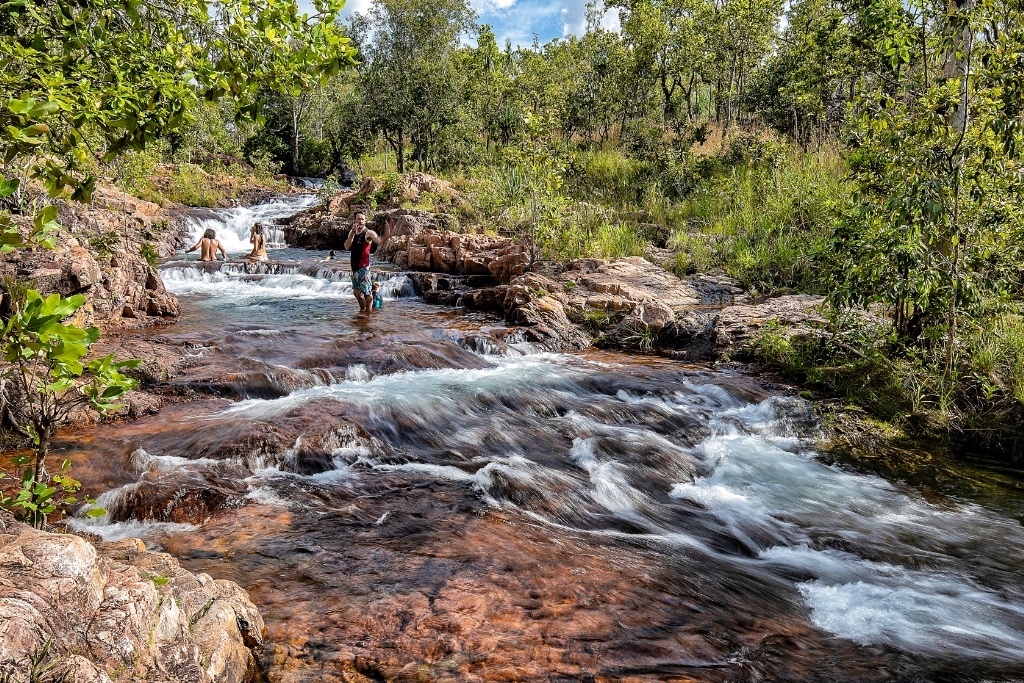
The Buley waterhole is easily accessible within a few minutes’ walk from the car park, with shower facilities available. For visitors planning to enjoy these nature facilities, it is recommended to stay overnight in the Litchfield area before returning to Darwin.
Florence Falls
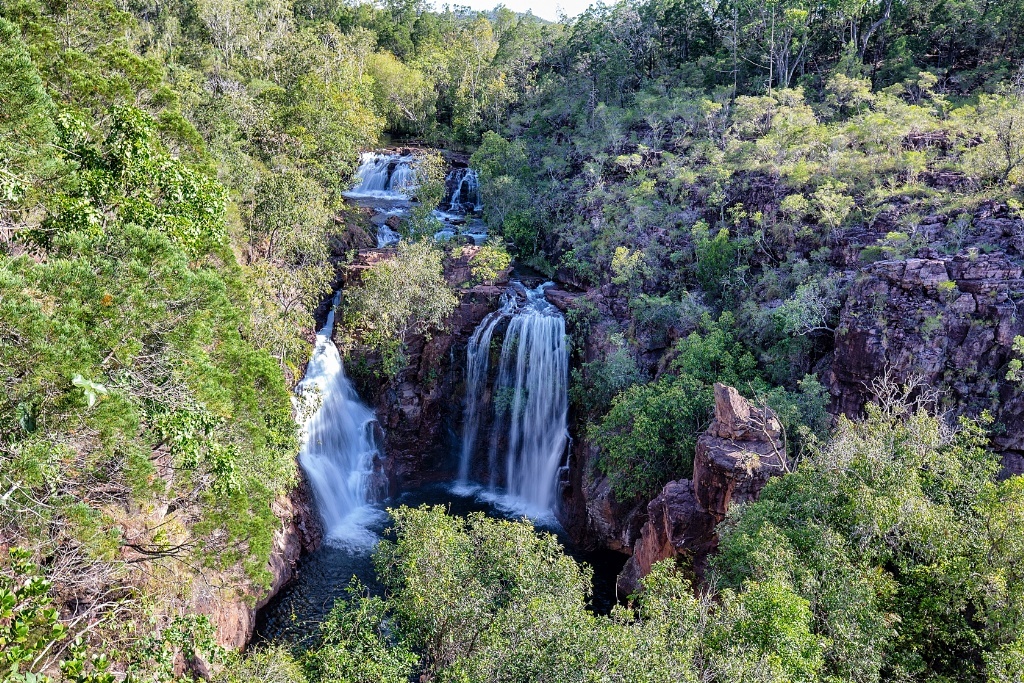
The pretty and scenic waterfall here and the pond below is perfect for swimming. Florence Falls will be probably most visitors’ favourite waterfall in Litchfield National Park. What made this waterfall stand out was its multi-tiered, multi-segmented shape with a crocodile-free swimming hole that is perfect for lingering about and cooling off.
Wangi Falls
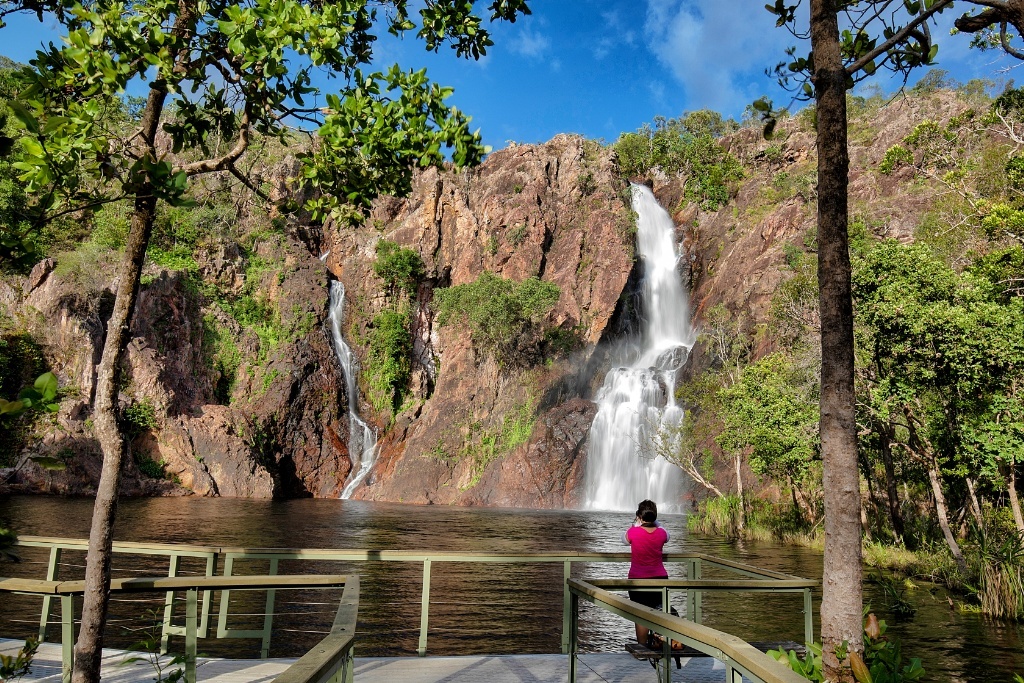
The Wangi Falls descend from an elevation of 84 metres (276 ft) above sea level via a series of segmented tiers that range in height between 41–52 metres (135–171 ft). The plunge pool at the base of the falls is a popular swimming spot, however, is often closed following significant rainfall due to sightings of crocodiles in the area

This is one waterfall you just have to shoot a picture with, before proceeding back to Darwin. Easily accessible and with short comfortable walking from the car park.
Day #5 – Continue the adventure @ Darwin city
Our final day in Darwin was scheduled with more fun and interesting activities. While we do missed the laidback ambience of the National Parks, we quickly realised nature is never far away even in the city attraction. Darwin is a compact city and the driving distance from most of the places to visit is pleasantly short, not more than 15-20mins from one another. This is the time you have to “switch on” city driving etiquette as well as take note of parking charges. Parking at streetside car parks is complimentary city-wide after 5 pm.
Fish feeding @ Aquascene
This marine sanctuary was established in 1981 and has become a magical attraction that anyone can enjoy – it attracts more than 70,000 visitors annually and has enjoyed widespread media coverage nationally and internationally. Parking at this venue is complimentary.
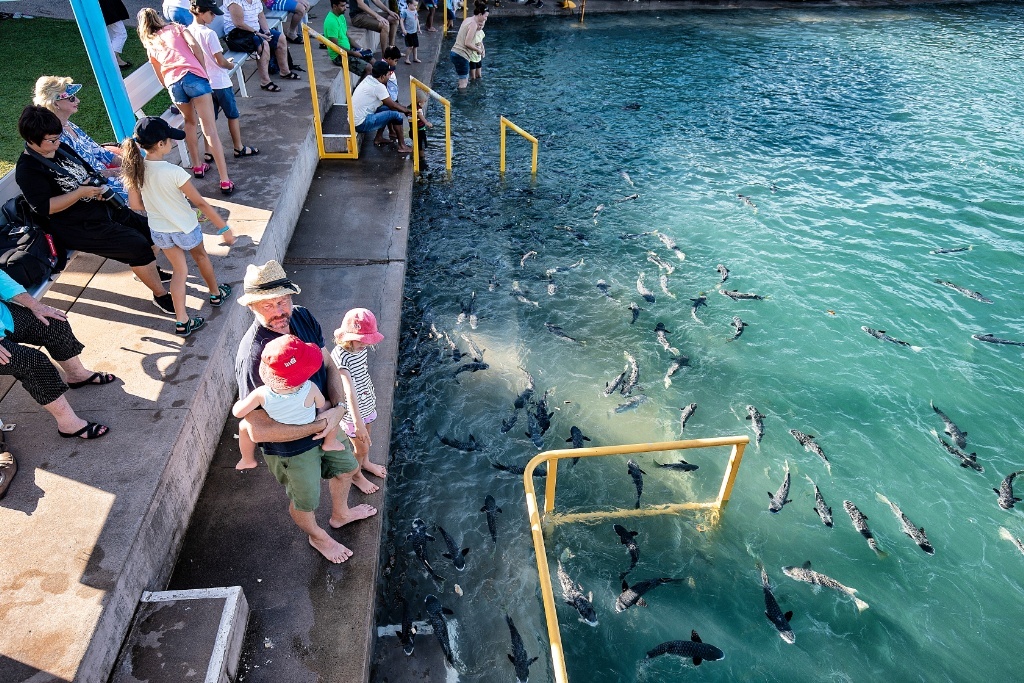
This attraction availability is directly linked to the large tidal movements of Darwin’s harbour, which can be up to eight metres. The fish can only visit Aquascene for a few hours each day before returning back to sea with the receding tide.
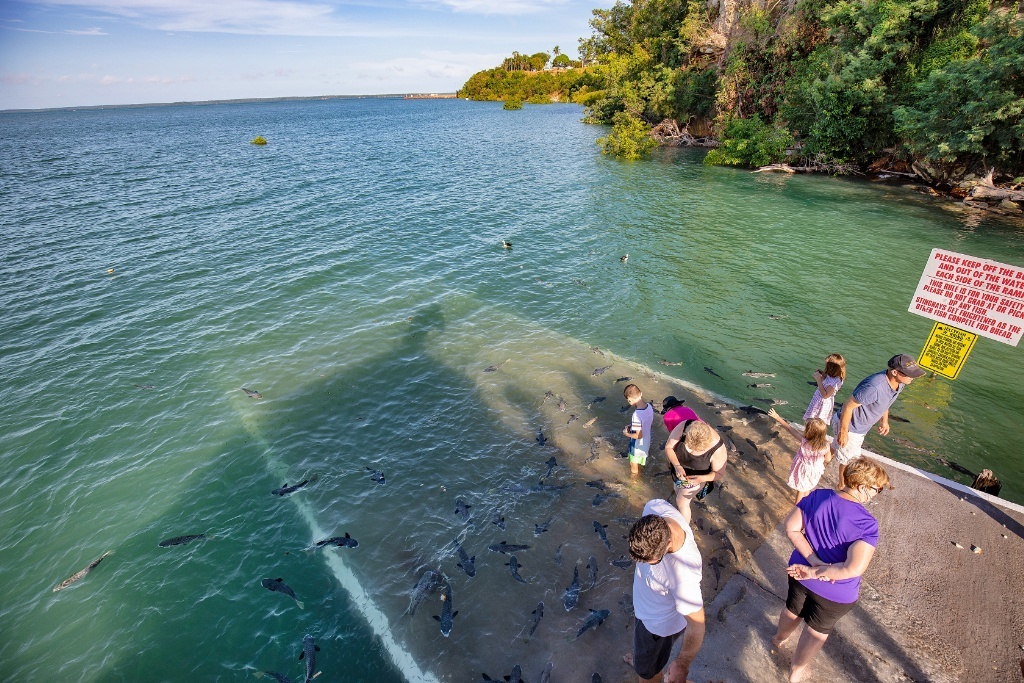
How many fish you see is determined daily by the tide size, wind and water clarity, breeding cycles and general seasonal weather conditions, but you will always see fish. Feeding sessions on deeper tides are usually best, with fish numbers at their highest between August to December.

The regular fish that comes include mostly milkfish, mullet, catfish, bream, batfish and barramundi. But if you look carefully outside the ‘main mob’ of fishes, you may spot stingrays, cod, mangrove jack, parrot and diamond fish. It’s an amazing experience considering these are fish from the open ocean.
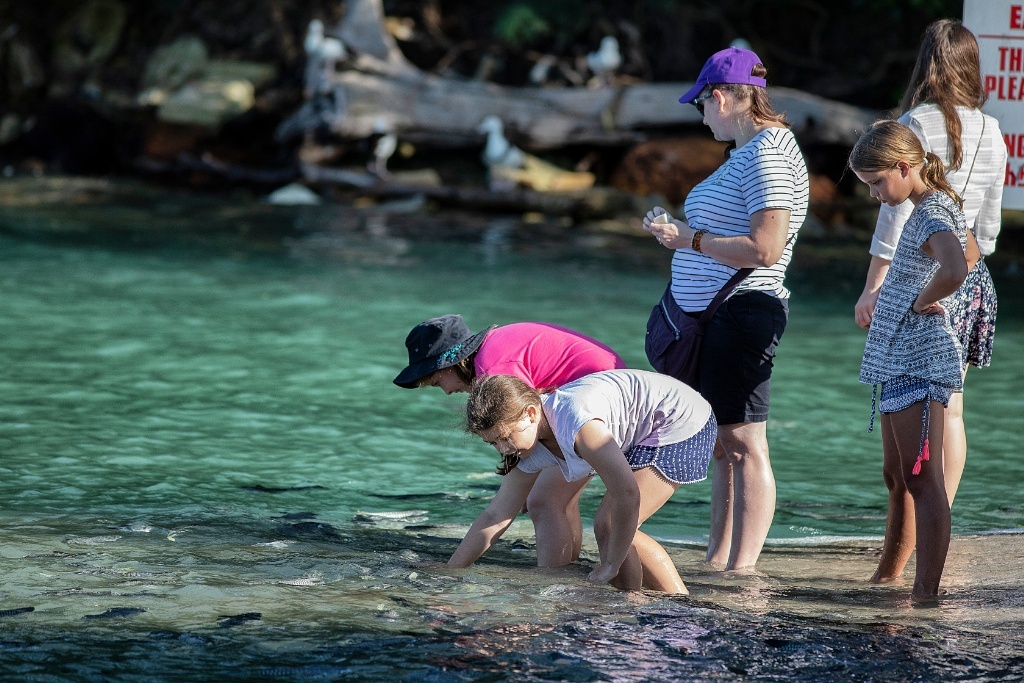
It is safe to wade in the waters amongst the feeding frenzy as the fish have no teeth or dangerous barbs. However, the sanctuary staff will advise visitors to wade no further than knee-deep during the box jellyfish months of October to May. No one has been stung at Aquascene as the huge school of fish seems to build a natural barrier.
Crocodile Dundee experience @ Crocosaurus Cove
This is the attraction that many of us would have seen in television commercials. The venue brings together some of the largest Saltwater Crocodiles in Australia and showcases the world’s largest display of Australian reptiles. Definitely, a must-see attraction when visiting Darwin. In fact, we would recommend going on the VIP tour which promises a much more intimate and memorable experience as group size is limited to 8 person. Parking at this attraction on the main street is subject to the daily rate.

This Darwin’s most famous crocodile attraction -The Cage Of Death. Perfect for those who like being up close to danger yet remains safe.
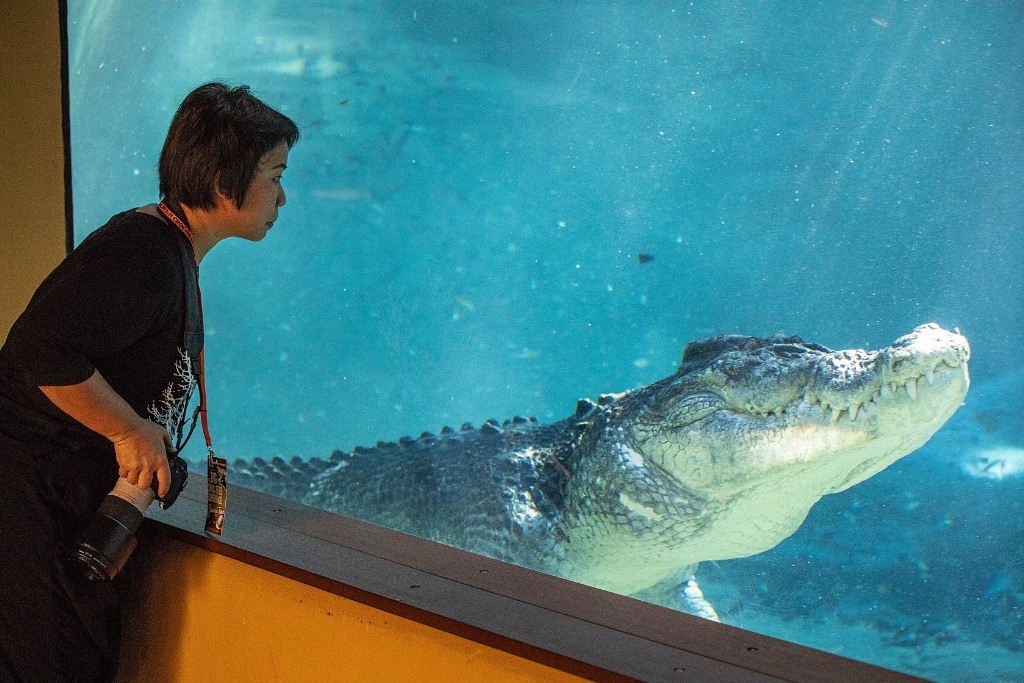
How’s that for size? A huge croc in there. Each of the long-time crocodiles is given a name and personal branding.

This is BURT! I think you might have seen him before in the movie Crocodile Dundee. This guy has a personality and is blinded its right eye. At 5.1m in length, 700kg, and age 80+, he’s the attraction’s most famous star indeed.
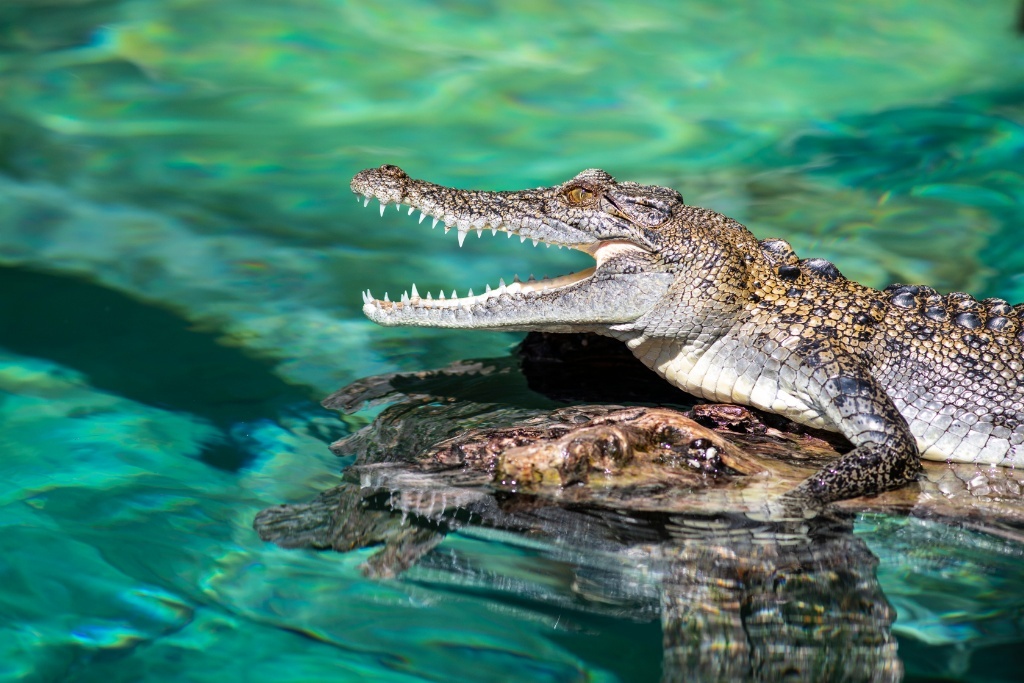
A juvenile cooling off in the sun, they open their jaws to dissipate heat from their body to keep cool.

With the VIP tour, you get to feed the croc as part of the activities. This close experience lets me realise 1st hand the immense power that a crocodile has.
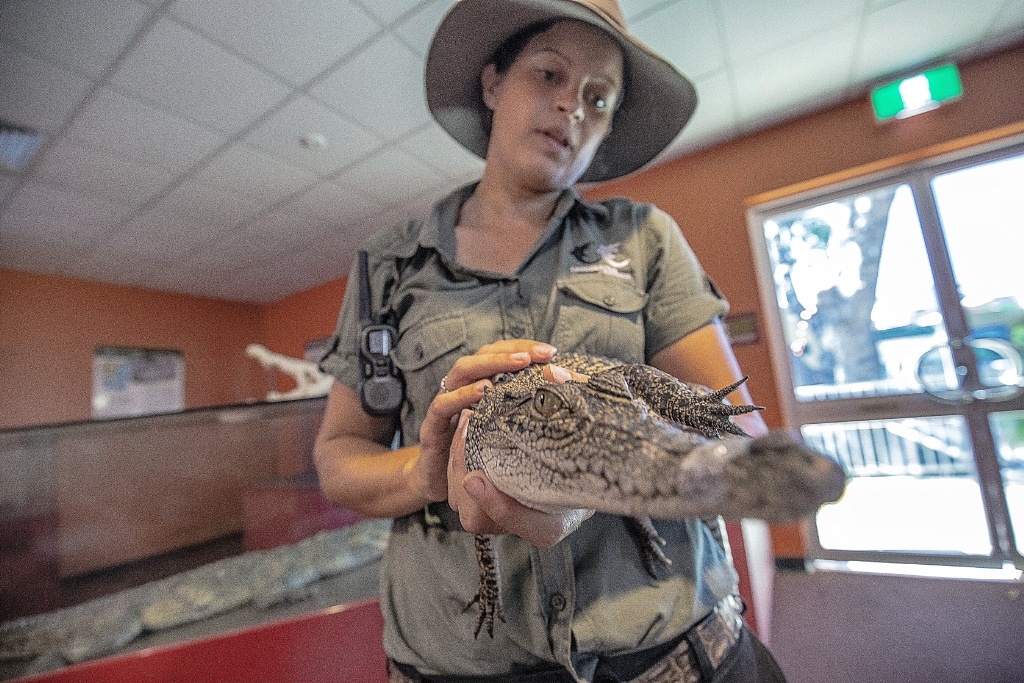
VIP tour also let us get to know the croc better. It is interesting to experience holding the ‘live’ leather ‘handbag’.
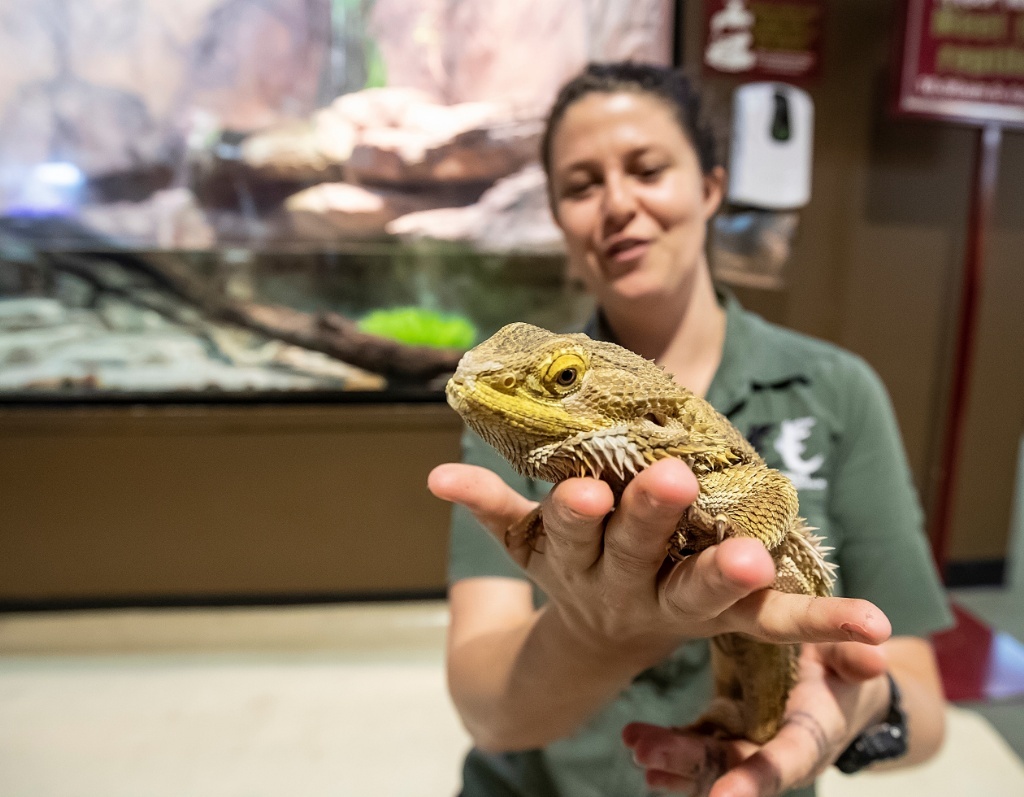
At the snake and lizard segment of the VIP tour, another ranger took over. Over here, we got to feel a Western Bearded Dragon.

A black-headed python. They will hiss loudly when disturbed but are unlikely to bite unless they are hunting prey. Although a strong swimmer, they are almost never found in water. They are non-venomous.
Museum and Art Gallery (MAGNT)
The Museum and Art Gallery of the Northern Territory (MAGNT) is the main museum in the Northern Territory. The building was opened on 10 September 1981. The museum features the history, science and visual art of the region and its people. I have not even visited Singapore National Museum but this visit convinced me that I should. Museums are not boring places but treasure troves of information. Entry to the MAGNT is free of charge.

The natural science section of the museum exhibits. They even have an authentic cathedral termites mound right inside! The MAGNT has a collection of over 1.2 million natural history specimens and over 30,000 items of art and material culture.
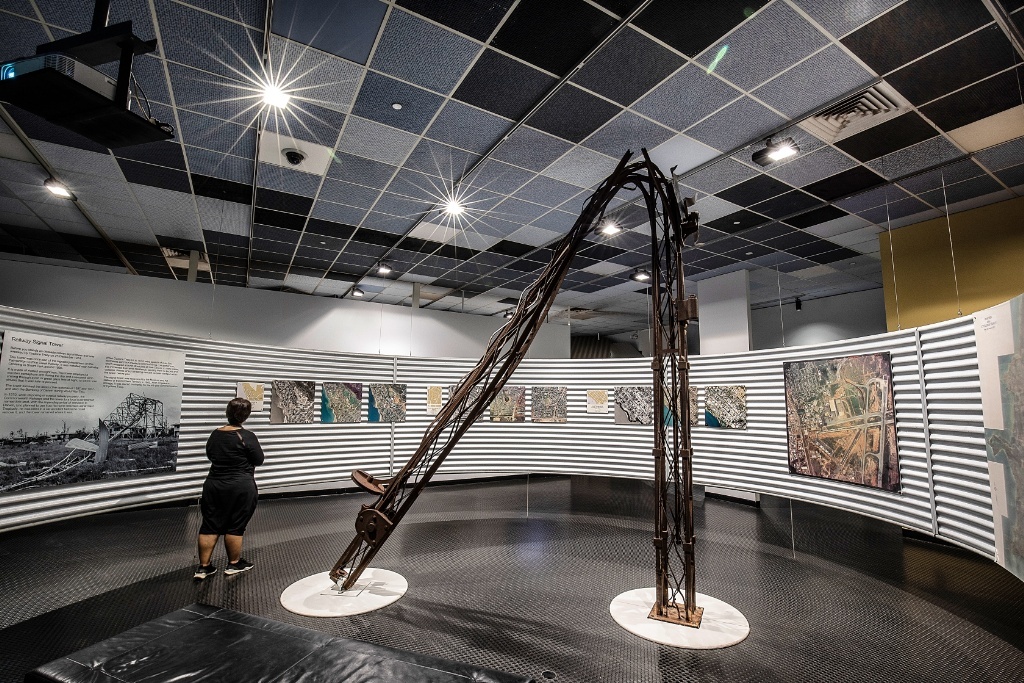
Between Christmas Eve to Christmas Day in 1974, Darwin was devastated by the Cyclone Tracy, killing 65 people and causing AUD$6.41 billion (2014 dollars) in damages. More than 70% of Darwin’s buildings were destroyed, including 80% of houses. This railway signal tower exhibit, which once formed part of the signalling equipment used on the Palmerston to Pine Creek Railway, was bent by the brute force of the cyclone. This tower is a symbolic reminder of the power of Cyclone Tracy but also of how far the Territory has come since that fateful night.
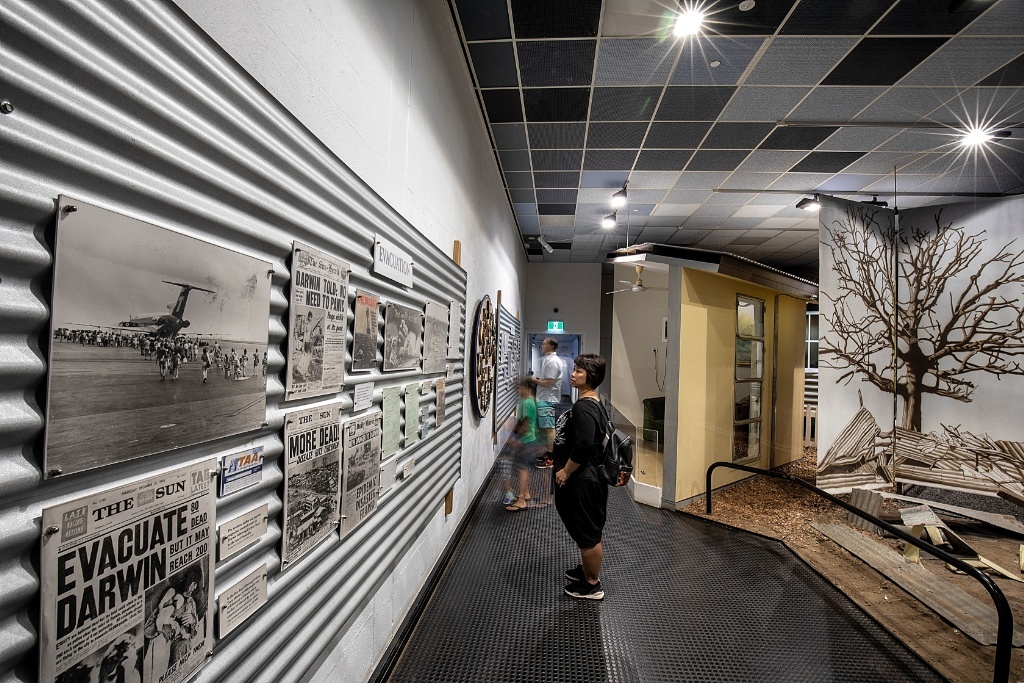
An exhibit on Cyclone Tracy shows how nature can affect humanity and change lives.
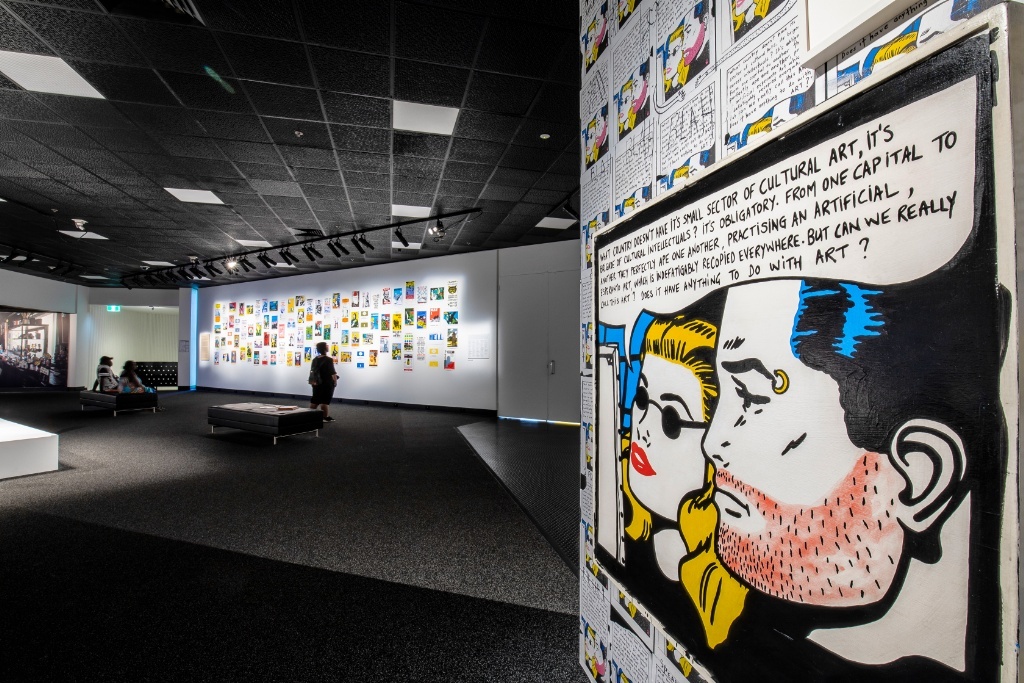
My favourite section of the museum exhibits, the art section. Almost felt like I stepped back into part of MONA, the gorgeous Museum of Old and New Arty in Hobart.
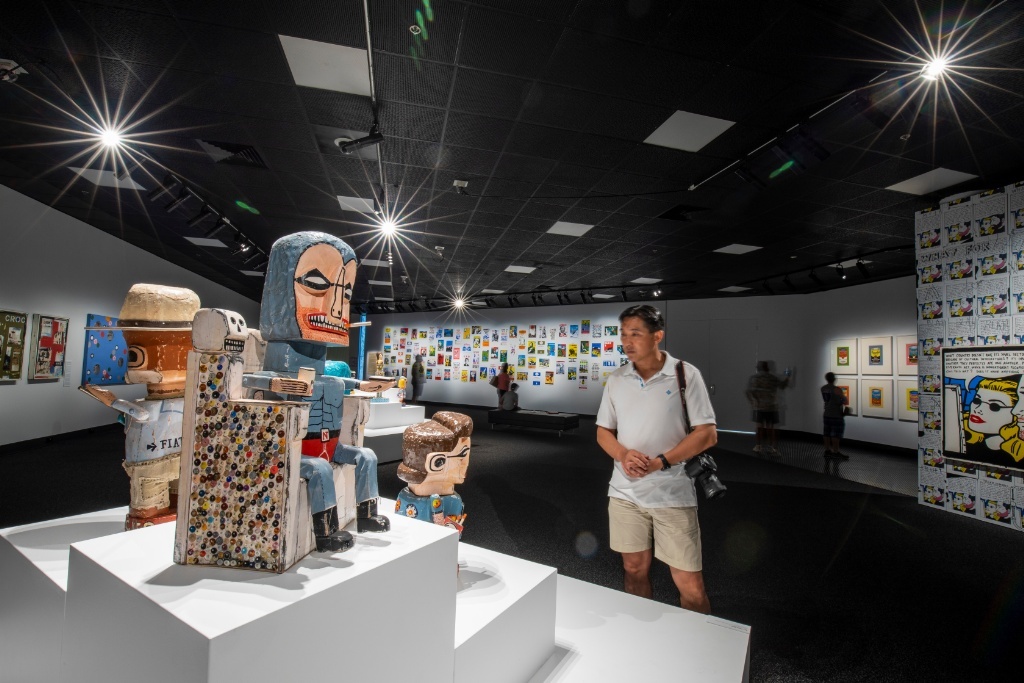
Visitors can expect variety as the MAGNT annually showcases both internally curated exhibitions and travelling exhibitions from around Australia. It is also the home of the annual Telstra National Aboriginal and Torres Strait Islander Art Award, Australia’s longest-running Indigenous art prize.

Great place to shoot some “artsy” pictures too. Take a moment, slow down and appreciate the beautiful and quirky creative expression.
Royal Flying Doctor Service (RFDS)
For history buffs, the Royal Flying Doctor Service of Australia (RFDS, informally known as The Flying Doctor) will be a highlight of the trip. It is one of the largest and most established aeromedical organisations in the world. It is a non-profit organisation which provides health care to people who cannot access a hospital or general practice due to the vast distances of the Outback. This service is invaluable for those residing in rural, remote and regional areas of Australia.

This branch at Darwin is located at the scenic Stokes Hill Wharf, just beside the waterfront. Parking at this venue is complimentary.

Treat yourself to the virtual reality presentation of the Japanese attack on Darwin Harbour during the 2nd world wall. The fateful 19 February 1942 event was the largest single attack ever mounted by a foreign power on Australia.

A life-sized mock of the Japanese Mitsubishi A6M (“Zero”) that attacked the Darwin Harbour.

A reconstructed Pilatus PC-12 display unit at the exhibition hall. The RFDS has 4 different planes that are used for operations and the national fleet is 66 planes strong and is growing each year.
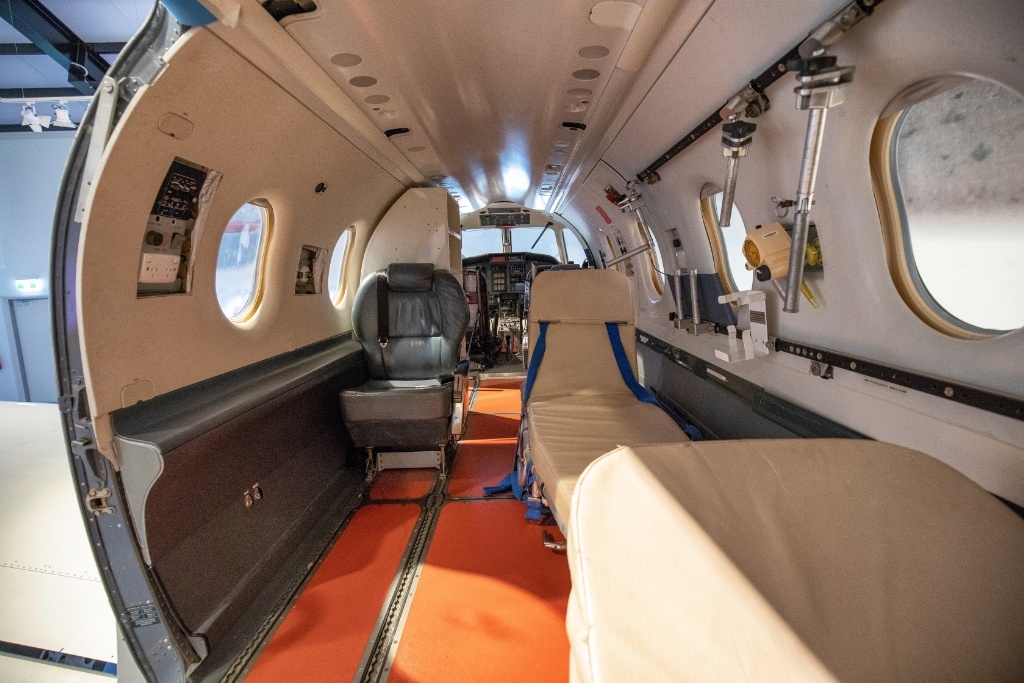
The cabin is set up with 2 stretcher beds and three seats, which can be used in a variety of configurations. The front door allows the pilot to conduct his pre-flight external inspections and enter the plane without disturbing the patients and medical crew in the rear.

The centre also featured the WWII exploits of Rear Admiral Etheridge Grant in a full-sized hologram presentation. War buffs will definitely love this feature segment.
Cape Adieu Dinner Cruise

A perfect way to wrap any trip to the Top End is a dinner cruise around the Timor Sea while enjoying the beautiful sunset.

Only locally fresh and wild-caught seafood are featured on the menu.
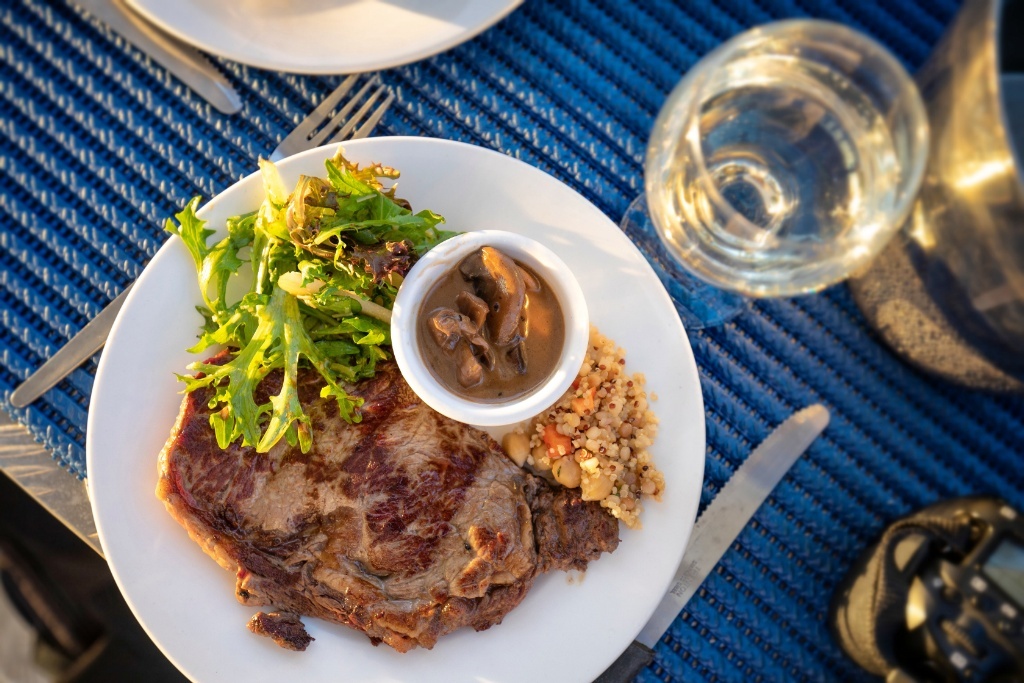
For the non-fish eaters, a generous portion of quality beef are offered as well.
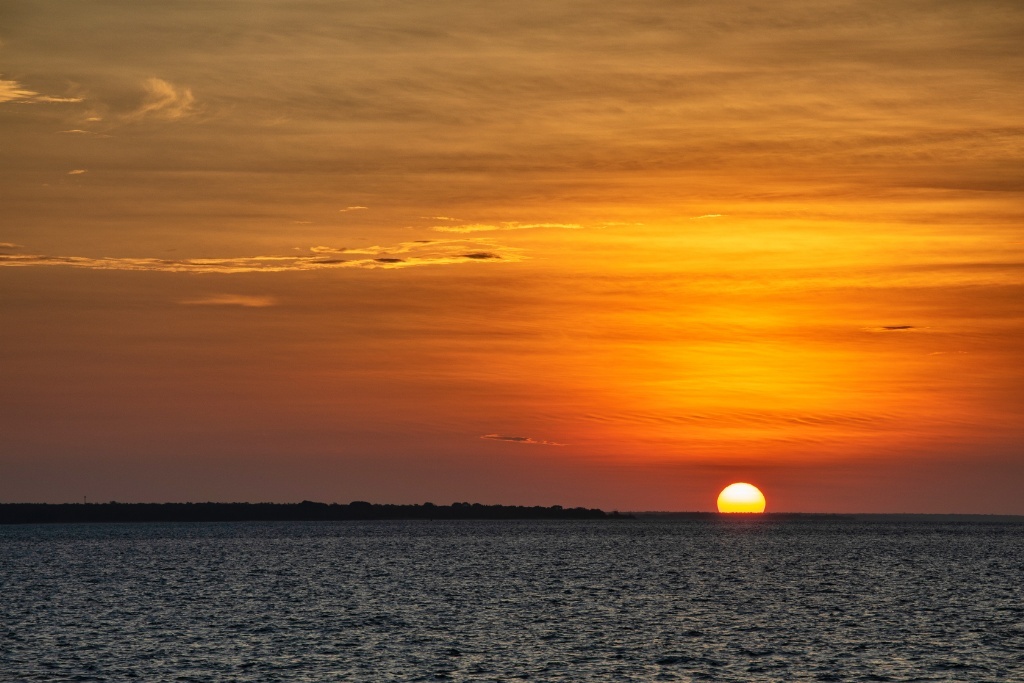
The gorgeous sunset at the Top End never fails to please. From day one until the last day of our NT exploration trip, the setting sun has always been a constant eye balm after each enjoyable day.
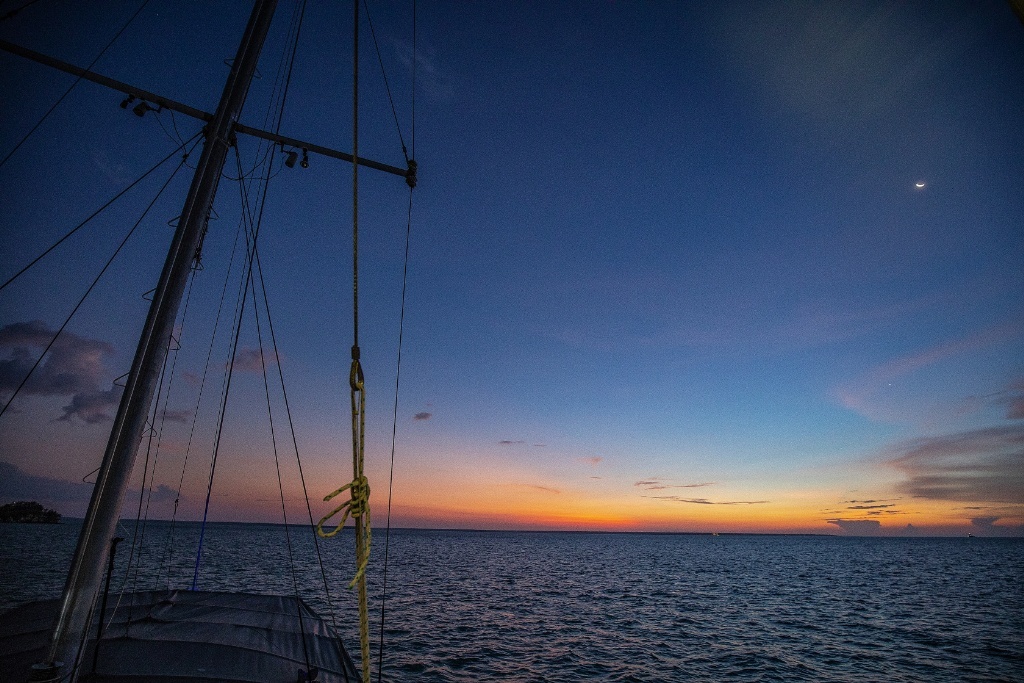
Don’t just enjoy the golden glow of dusk, the blue hour that follows are mesmerizing as well.
Conclusion
This short adventure to the Top End was certainly an eye-opener and truly spectacular in every sense of the word. Having experienced various regions of Australia, I can speak with conviction that anyone who eschews mass tourism, keen for a great road trip, loves fabulous nature, appreciates local culture, cuisine and friendly locals- will savour the moments at this region that defies description. This exploration was too short and there is so more to uncover. Perfect reason for revisits in the near future indeed.
N.B: For my travelogues to other parts of Australia, readers might like to have a look here.
Footnote: All pictures used in this travelogue are copyrighted to Jensen Chua Photography and all rights reserved. The opinion expressed is factual, objective and that of the author.